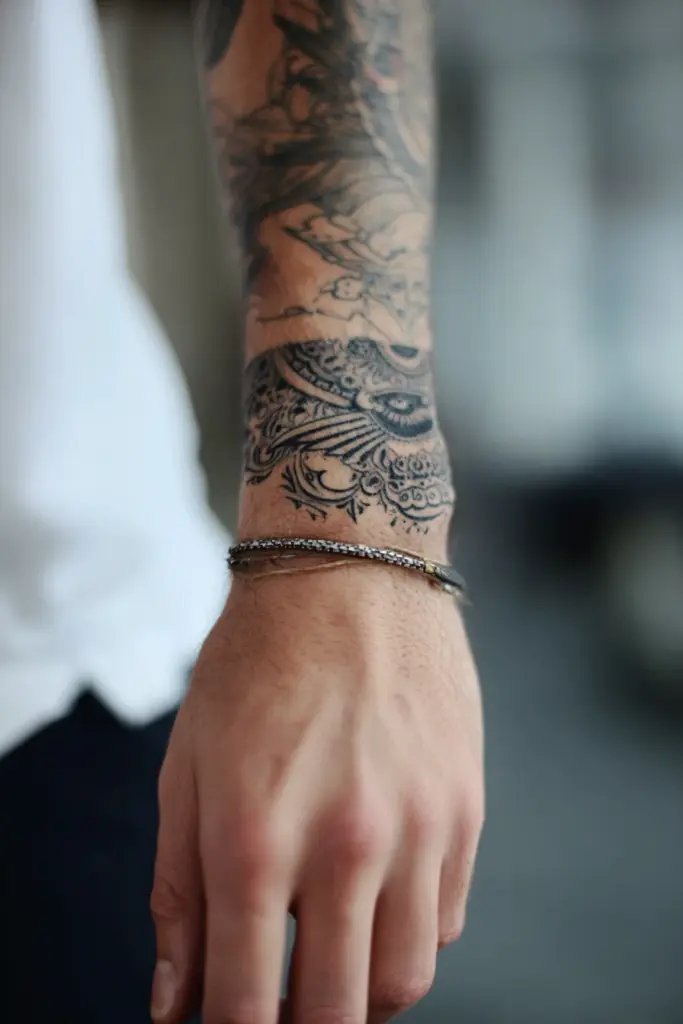I’m Hakan — a tattoo consultant and designer with 10+ years working across studios and private clients. In this post I’ve curated 28 wrist tattoo ideas for men, with practical guidance on styles, placement, pain and long-term care. Wrist tattoos suit men who want a visible, personal statement — from subtle minimalist lines and script to bold tribal bands and micro-geometric pieces. They also work well as anchors for half-sleeves or matching couples’ tattoos. In my consultations I focus on anatomy, movement, skin tone, and lifestyle so designs age well and sit comfortably on the radial or ulnar side. Practical tips: choose scale carefully (the wrist has limited canvas), test orientation with a temporary stencil, expect sharper fading from sun and friction, plan for touch-ups, and pick an experienced artist familiar with small-detail work. Below I include 28 curated images and notes to help you choose the right wrist design.
Polynesian Tribal Wrist Band — Geometric Forearm Armband Tattoo
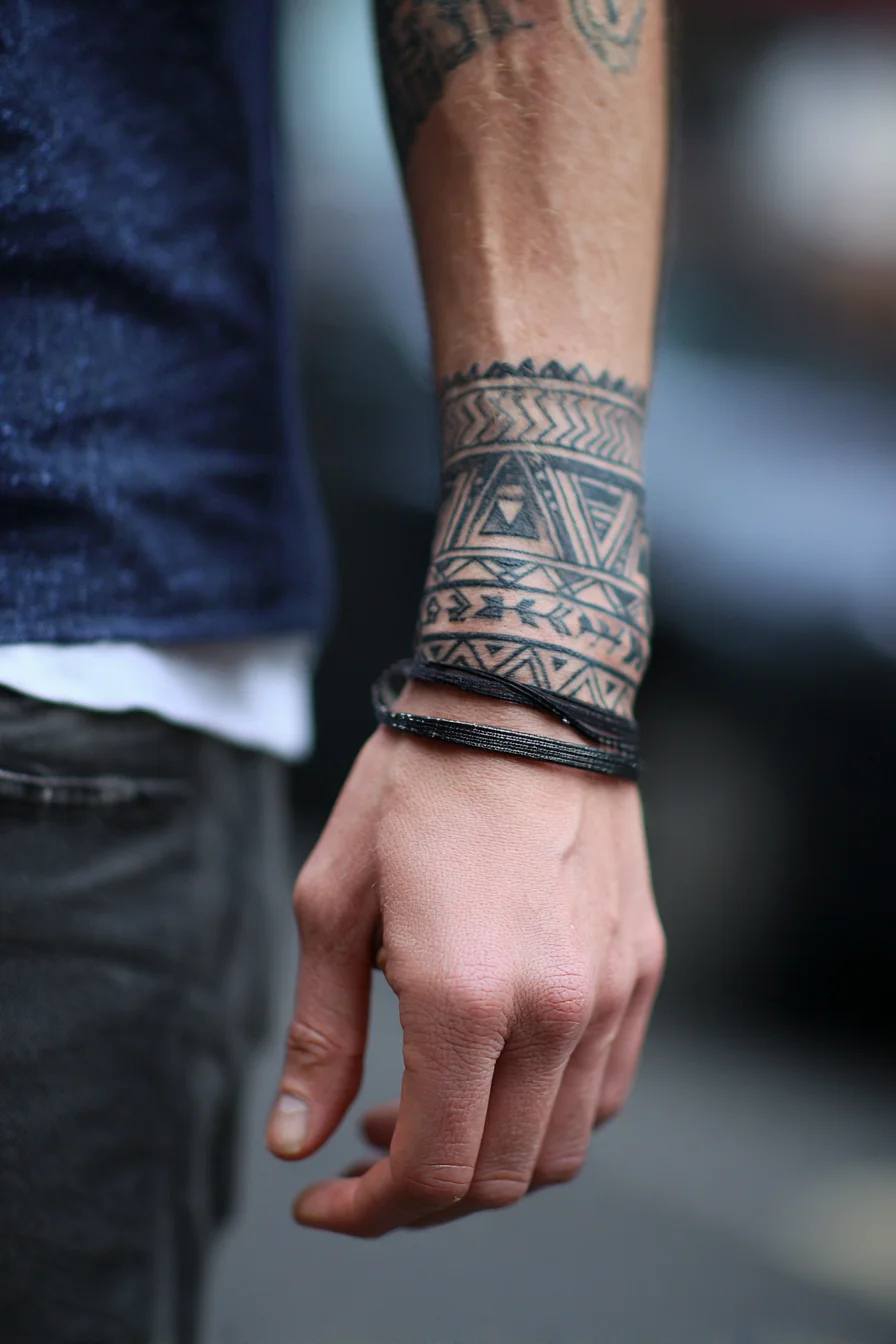
This bold Polynesian-inspired cuff features repeating triangles, chevrons and wave-like bands that read as a strong geometric armband. Traditionally, these motifs symbolize protection, strength, family lineage and a connection to the sea and navigation — qualities many men choose to express through forearm work. Placement works best as a wrist cuff or just above the wrist on the outer forearm; it also translates well as a bridge into a half- or full-sleeve. Expect pain to range from low-to-moderate on the outer forearm (thicker skin and muscle) to higher sensitivity directly over the wrist and inner forearm where bone and thin skin lie. For sizing, choose a cuff width that balances visibility and mobility — 2–5 cm is common for a wrist band, larger for a statement wrap — and favor slightly thicker lines and breathing space between elements to prevent blowout as the ink ages. Styling variations include solid blackwork, negative-space patterns, dotwork shading, subtle color accents, or integrating tribal elements with realism or lettering. Discuss scale, symmetry and future extension with your artist during consultation.
Ornamental Blackwork Wrist Band Tattoo — Geometric Floral Forearm Cuff
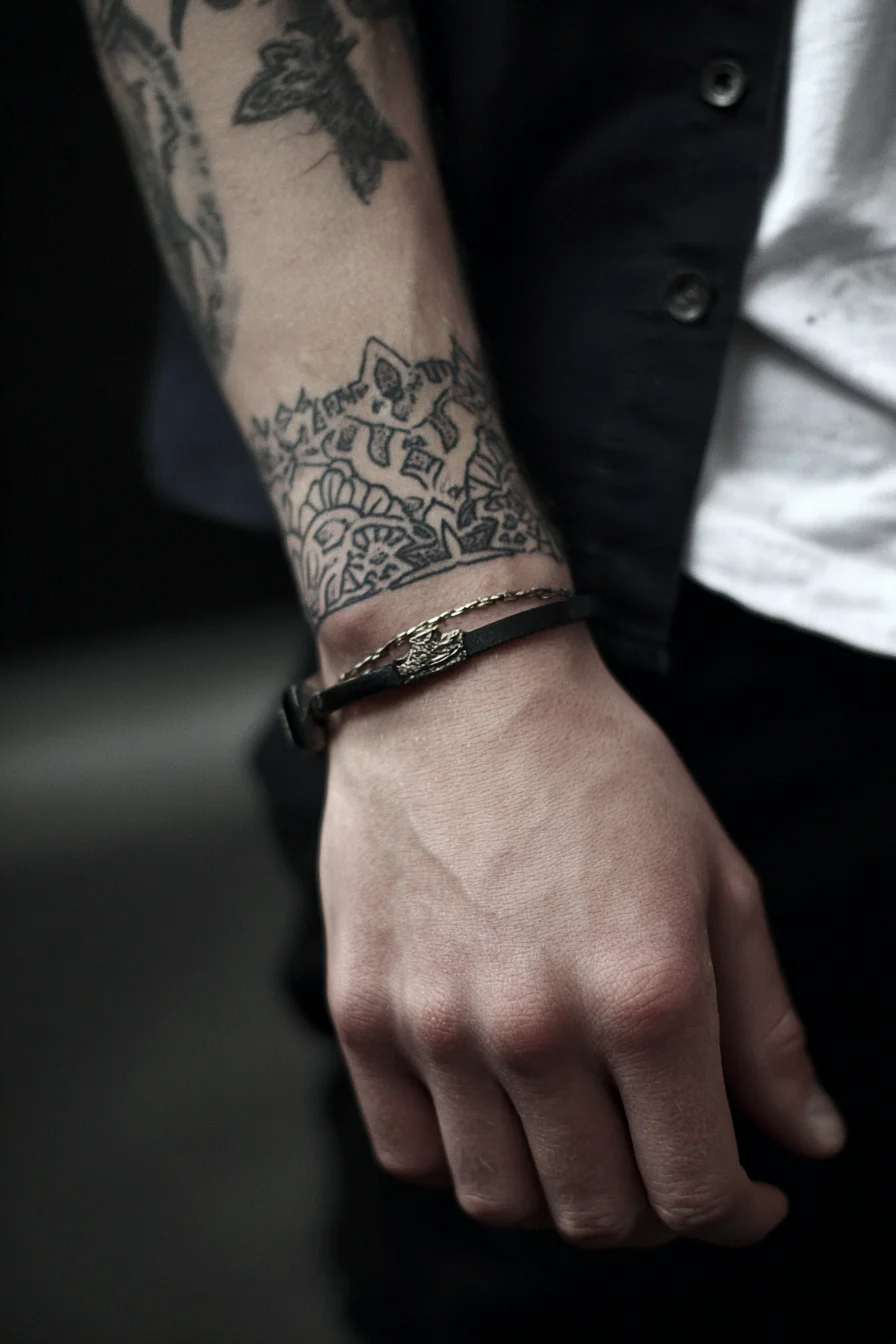
This ornamental blackwork wrist band combines geometric motifs and floral filigree into a cuff-style forearm tattoo. Symbolically it reads as balance and continuity — the repeated shapes convey discipline and personal boundaries, while the floral elements add organic contrast. Placement works well on the distal forearm or wrapped around the wrist; the piece in the photo sits on the outer wrist and translates cleanly to inner wrist, forearm band, or connected sleeve. Pain expectations: expect moderate discomfort over soft flesh and higher sensitivity along the ulna, wrist bone and near the tendons — areas closer to bone feel sharper, while the fleshy outer forearm is milder. Size considerations: maintain proportional line weight; narrow bands (1–2 cm) require very fine detail and higher upkeep, whereas wider cuffs (3–8 cm) allow more complex patterns and negative space. Styling variations: adapt to bold blackwork for longevity and stark contrast, fine-line dotwork for a subtler look, or add muted color washes for emphasis. Discuss wrapping, symmetry, and how it pairs with bracelets with your artist during consultation.
Mandala Blackwork Wrist Cuff Tattoo — Ornamental Forearm Band
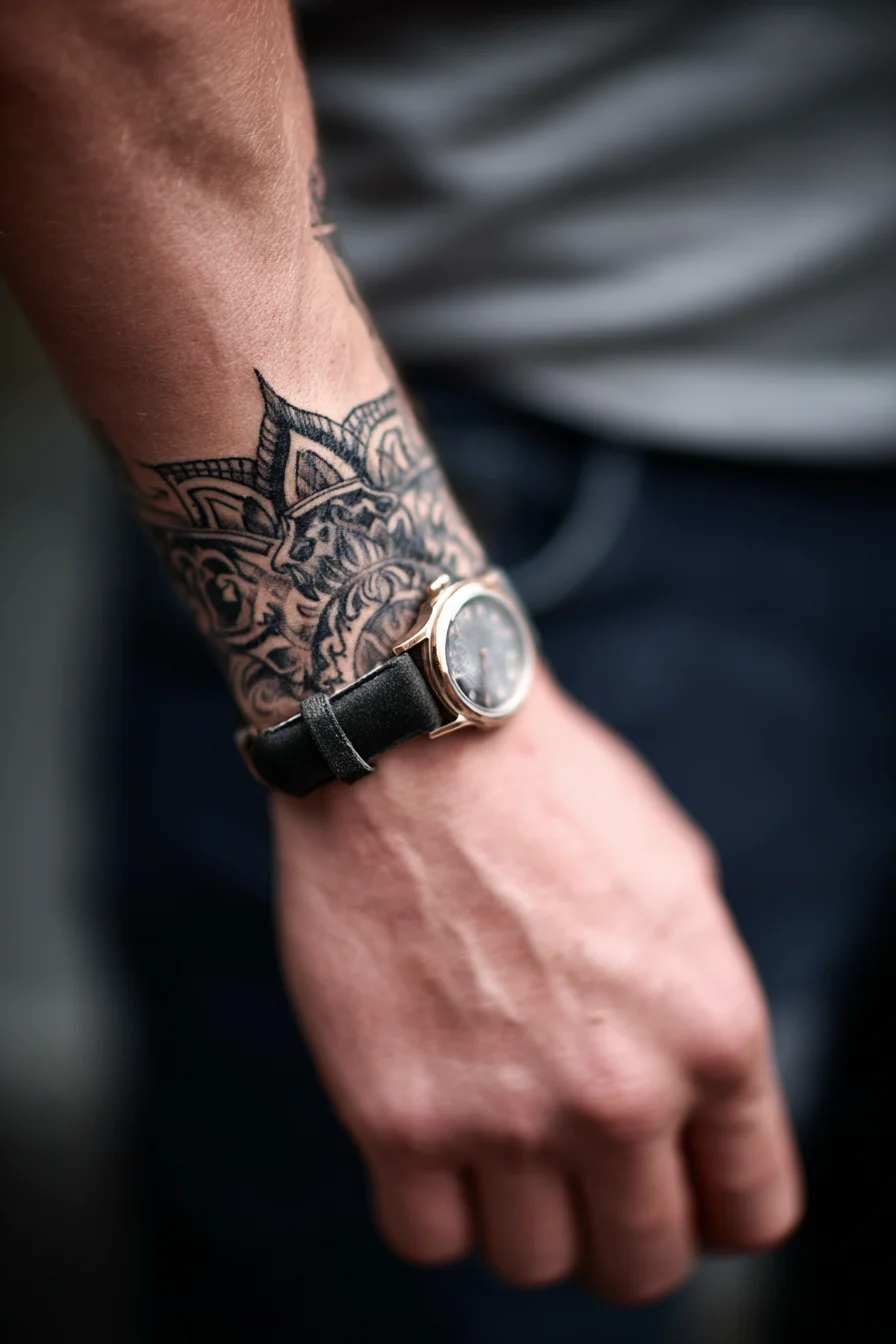
This mandala-style blackwork cuff blends geometric symmetry and ornamental flourishes to convey balance, focus and personal resilience. As a wrist/forearm piece it reads bold and purposeful — a design that works well for men seeking a refined yet masculine aesthetic. Placement suggestions: wear it as a low wrist cuff just above the watch line, on the inner forearm for a more intimate look, or extend it into a half-sleeve that wraps toward the elbow. Pain expectations: the outer forearm is one of the easier areas with low-to-moderate discomfort; the inner wrist and bony wrist joint are noticeably more sensitive and can be sharp during long sessions. Size considerations: small cuffs (2–3 inches) suit minimalist tastes but limit fine detail; medium-to-large pieces allow intricate linework and negative-space shading without risking blowout. Styling variations: full blackwork for high contrast, dotwork or stippling for texture, negative-space mandalas for modern contrast, or selective color accents (deep reds/blues) to highlight focal points. Consult your artist on stencil placement, skin type, and touch-up expectations, and plan aftercare to preserve crisp lines.
Geometric Tribal Blackwork Wrist Band Tattoo — Bold Wrist Cuff
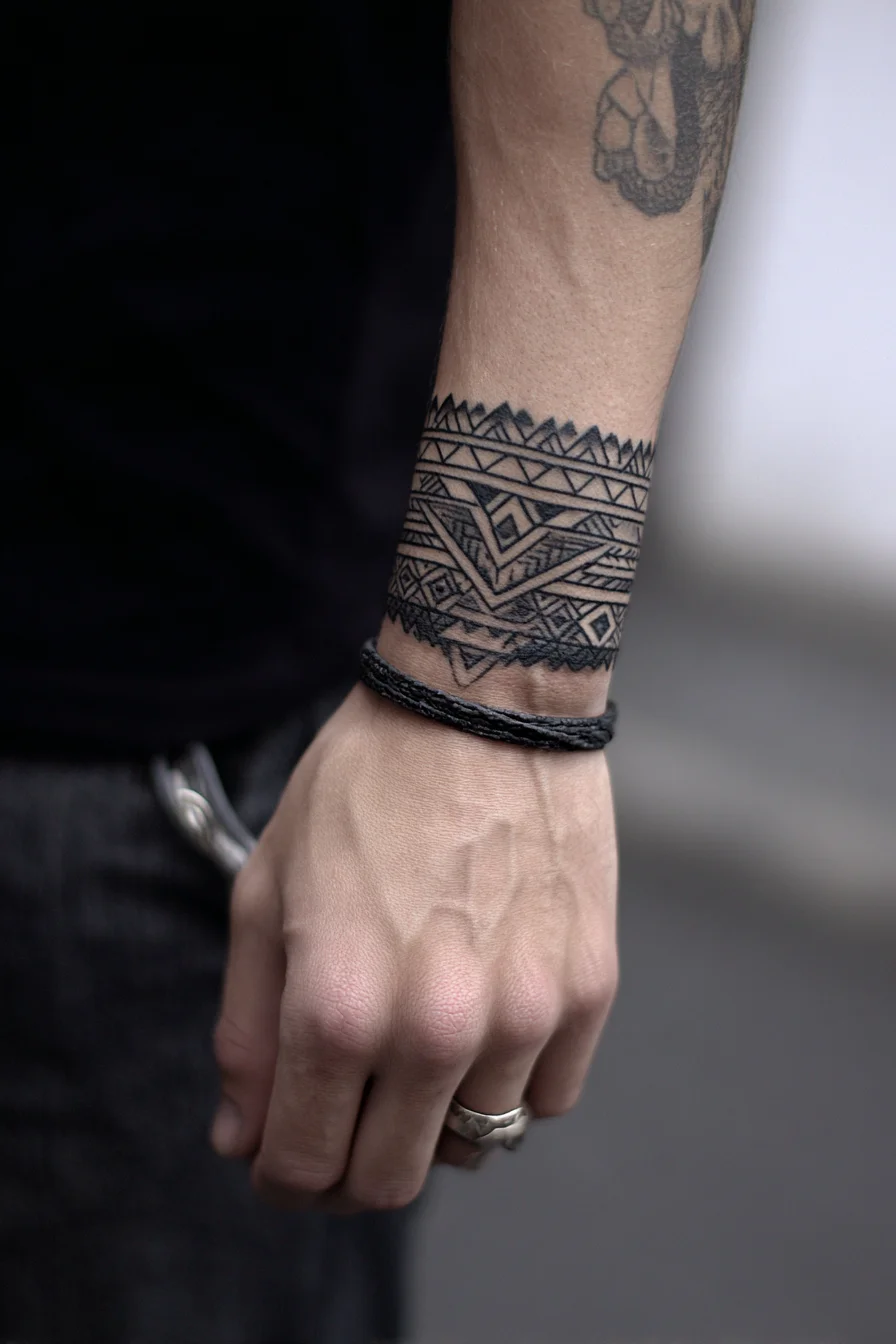
This geometric, tribal-inspired wrist band reads as a bold blackwork cuff that blends sharp lines, repeating patterns, and negative space for a masculine, modern look. Meaning: the symmetry and interlocking shapes commonly convey strength, continuity, and personal boundaries — a good choice for men who want a visible symbol of resilience or heritage without an explicit motif. Placement suggestions: ideal around the distal forearm or wrist as shown; it also scales well as an upper forearm cuff or as the base of a half-sleeve extension. Pain level expectations: the wrist and bony parts of the forearm are moderately to more painful than fleshy areas — expect sharper sensations near the ulna and less discomfort on the meatier inner forearm. Size considerations: width and wrap continuity matter — narrow bands (1–2 cm) feel subtle while wider cuffs (3–6+ cm) make a stronger statement and require precision to stay symmetrical. Styling variations: solid black fills, fine line dotwork, added color accents, or integrating tribal motifs and negative-space chevrons; discuss line weight and touch-up plans with a skilled artist to account for sun exposure and friction around the wrist.
Geometric Tribal Wrist Band Tattoo — Bold Forearm Band Design
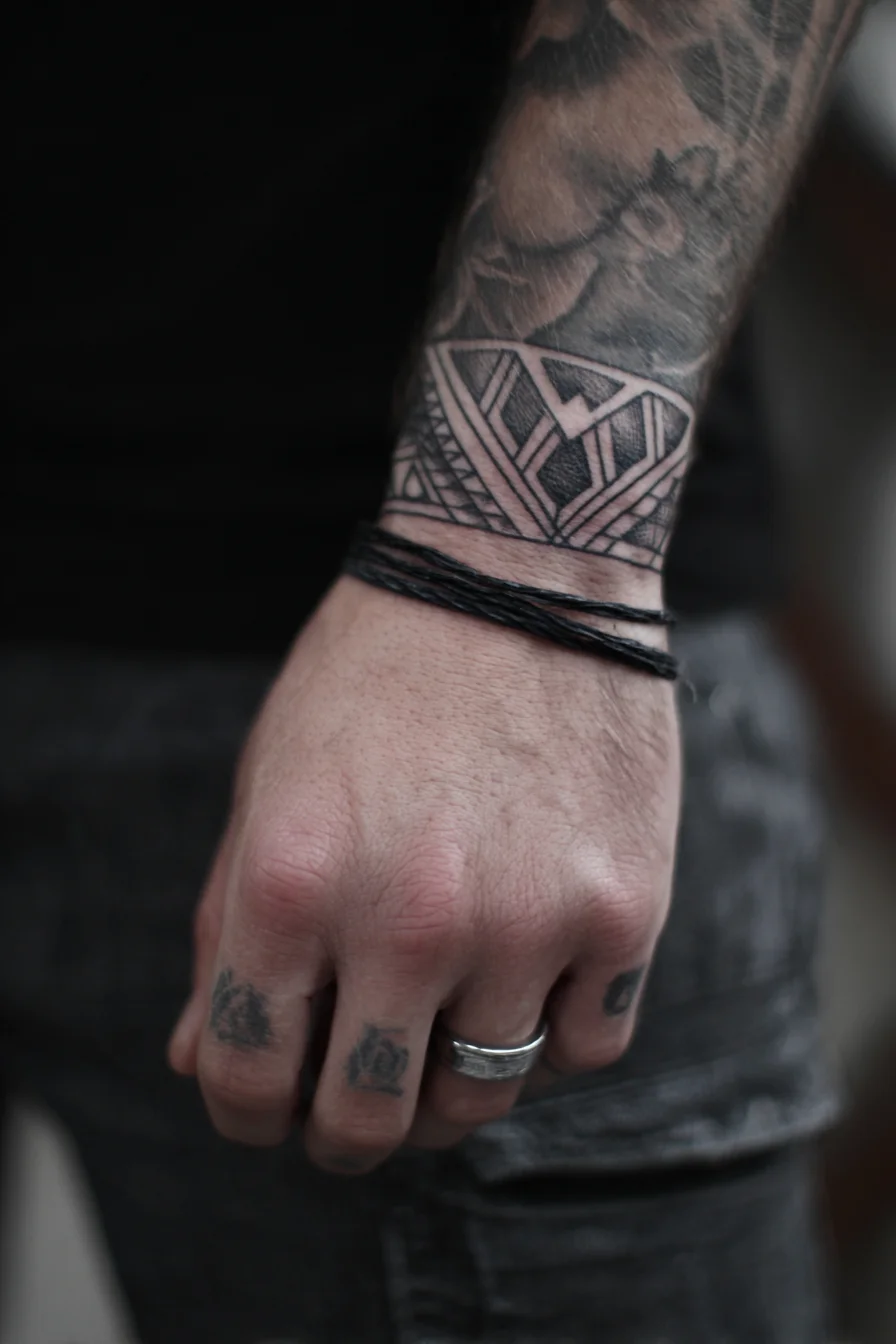
This geometric tribal wrist band blends crisp linework and negative-space shading to create a bold, masculine statement. Symbolically it reads as continuity, protection, and resilience—qualities commonly chosen by men who want a visible, wearable emblem. Placement suggestions: the inner wrist or just above the wrist joint is ideal for a band that reads clearly; extend the pattern into the forearm for a half-sleeve effect or mirror it on the opposite arm for balance. Pain level expectations: the wrist and inner forearm are sensitive due to thin skin and proximity to bone and tendons—expect moderate to higher discomfort, while small finger motifs can be significantly more painful and prone to faster fading. Size considerations: keep band width between 1–4 cm for wrist placement; intricate geometry needs more surface area (larger diameter) to retain detail over time. Styling variations: solid black tribal, fine-line geometric, dotwork shading, or a negative-space motif with white-ink highlights. Consider color accents or connecting the band to sleeve work; plan for sun protection and periodic touch-ups to preserve crisp edges.
Black-and-Grey Winged Lion with Cross — Forearm Sleeve Tattoo
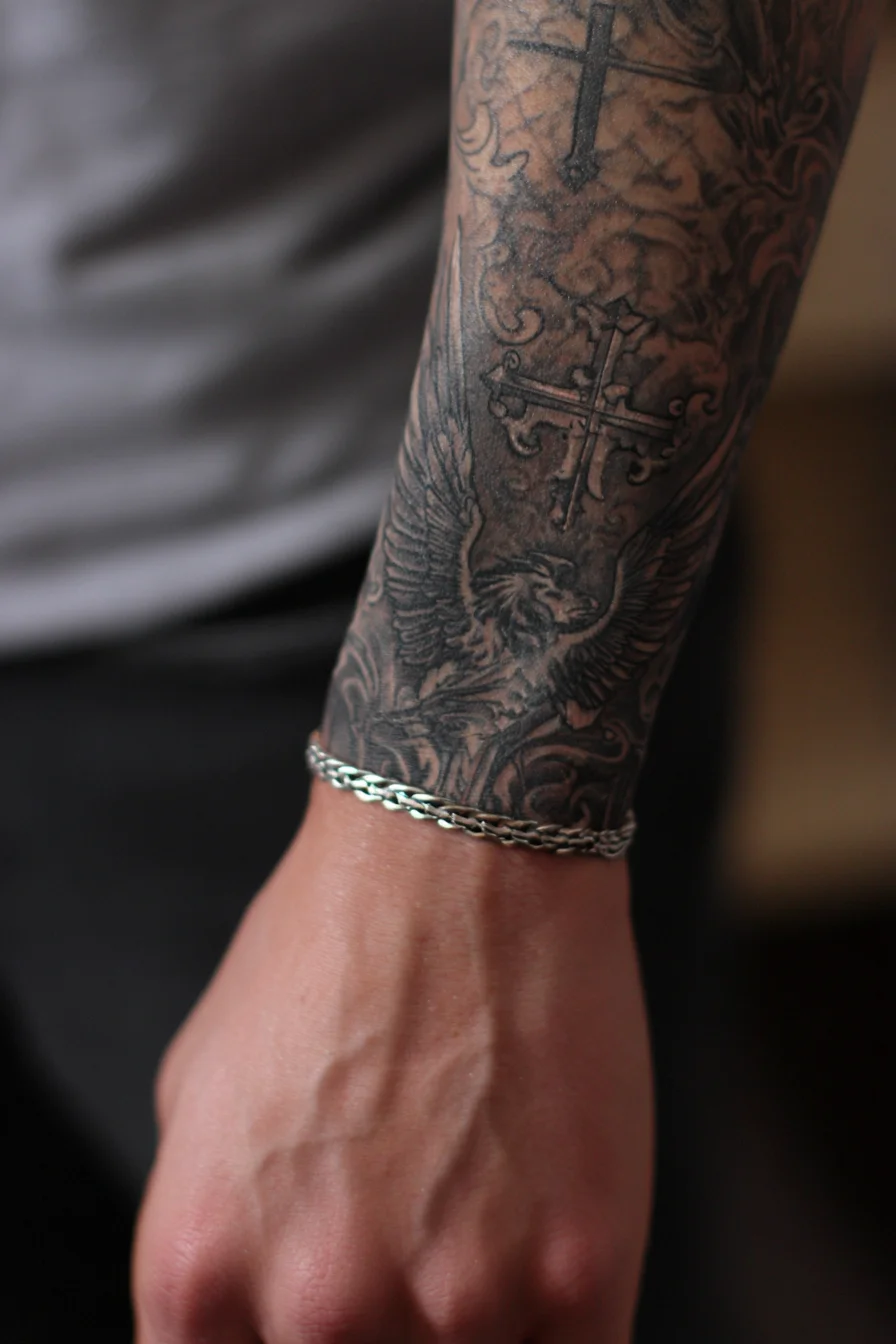
This black-and‑grey forearm piece pairs a decorative cross with a winged lion/griffin motif, blending religious symbolism and guardian imagery to communicate protection, courage and personal conviction. As a forearm design it reads well in motion and works equally as a standalone cuff or part of a half- to full‑sleeve composition. Placement suggestions: outer forearm for visibility and lower pain, inner forearm for a more intimate feel, or extended up the arm to integrate with chest or shoulder work. Expect a moderate pain level — the fleshy outer forearm is among the easier spots, while areas near the wrist, ulna or elbow will be noticeably more sensitive. Size considerations: preserve the facial and feathered details by keeping the main motif at least 4–6 inches tall; larger pieces allow for richer shading and contrast that ages better. Styling variations include high‑contrast blackwork for longevity, added subtle color accents (gold/red) to highlight the cross, neo‑traditional line work for bolder shapes, or fine‑line realism for detailed feathers. Consult your artist to adapt line weight and negative space for your skin tone and lifestyle.
Blackwork Forest Wristband Tattoo — Pine Silhouette Cuff for Men
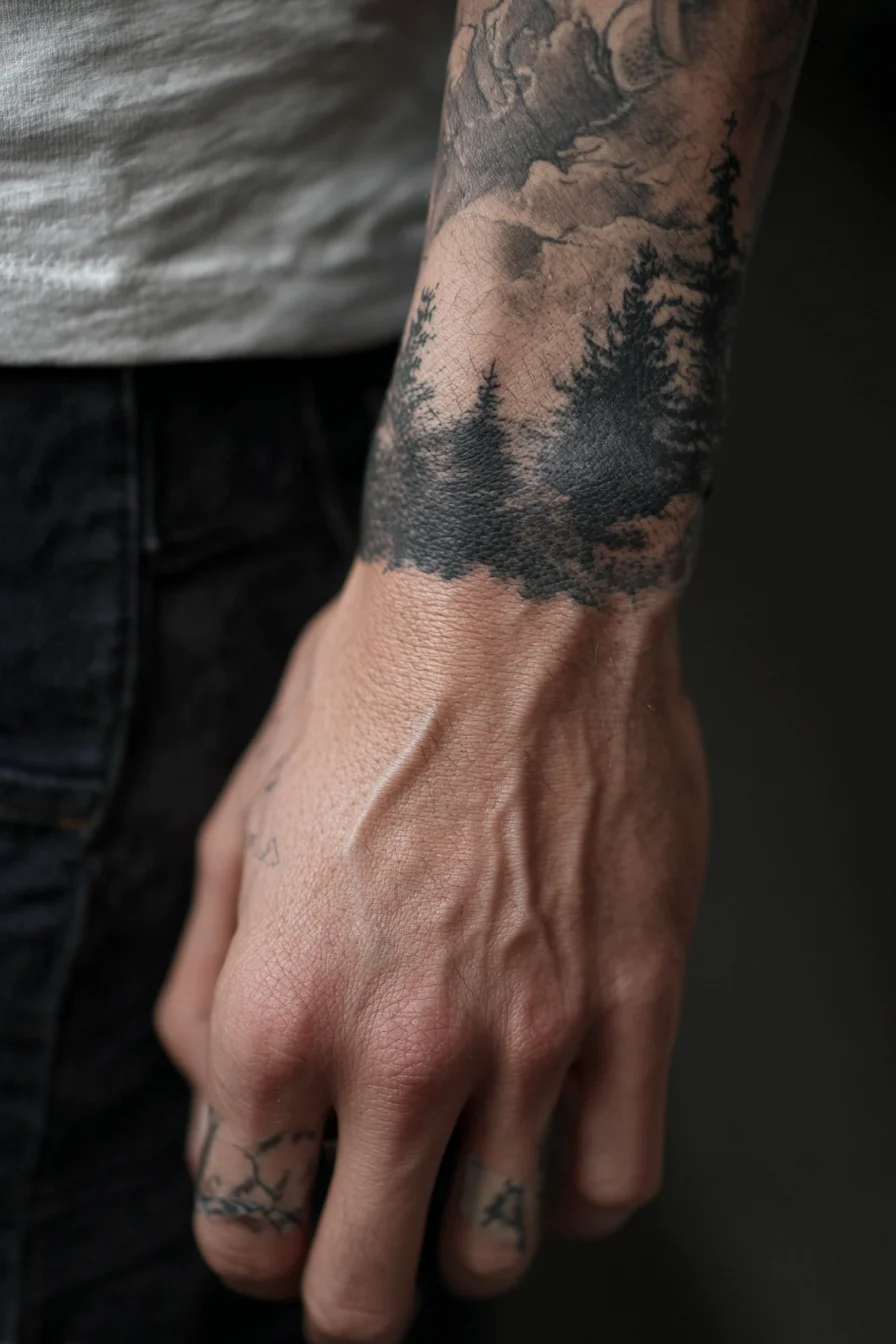
This blackwork pine-forest wristband reads as a compact landscape that symbolizes resilience, solitude, and a connection to nature. As a cuff or partial sleeve it works well for men wanting a bold, masculine statement that still reads organic and wearable. Placement suggestions: wrap the design around the wrist or extend it up the forearm into a half-sleeve for more detail; outer wrist and distal forearm show best with everyday clothing. Pain expectations: the wrist and top of the hand can be moderately uncomfortable because of thin skin and proximity to bone — expect a 5–7/10 level of discomfort during saturation work; the thicker forearm is noticeably less sensitive. Size considerations: keep fine-detail scenes at least 3–4 cm tall to avoid loss of clarity over time; dense black silhouettes hold up well but require proper spacing to prevent blowout. Styling variations: pure black silhouette, dotwork shading gradients, negative-space highlights for moon or fog, small color accents (deep green or amber), or extension into geometric framing. Consult an experienced blackwork artist to refine scale, line weight, and aftercare for long-lasting contrast.
Black-and-Grey Rose Cuff Tattoo — Forearm Floral & Skull Realism
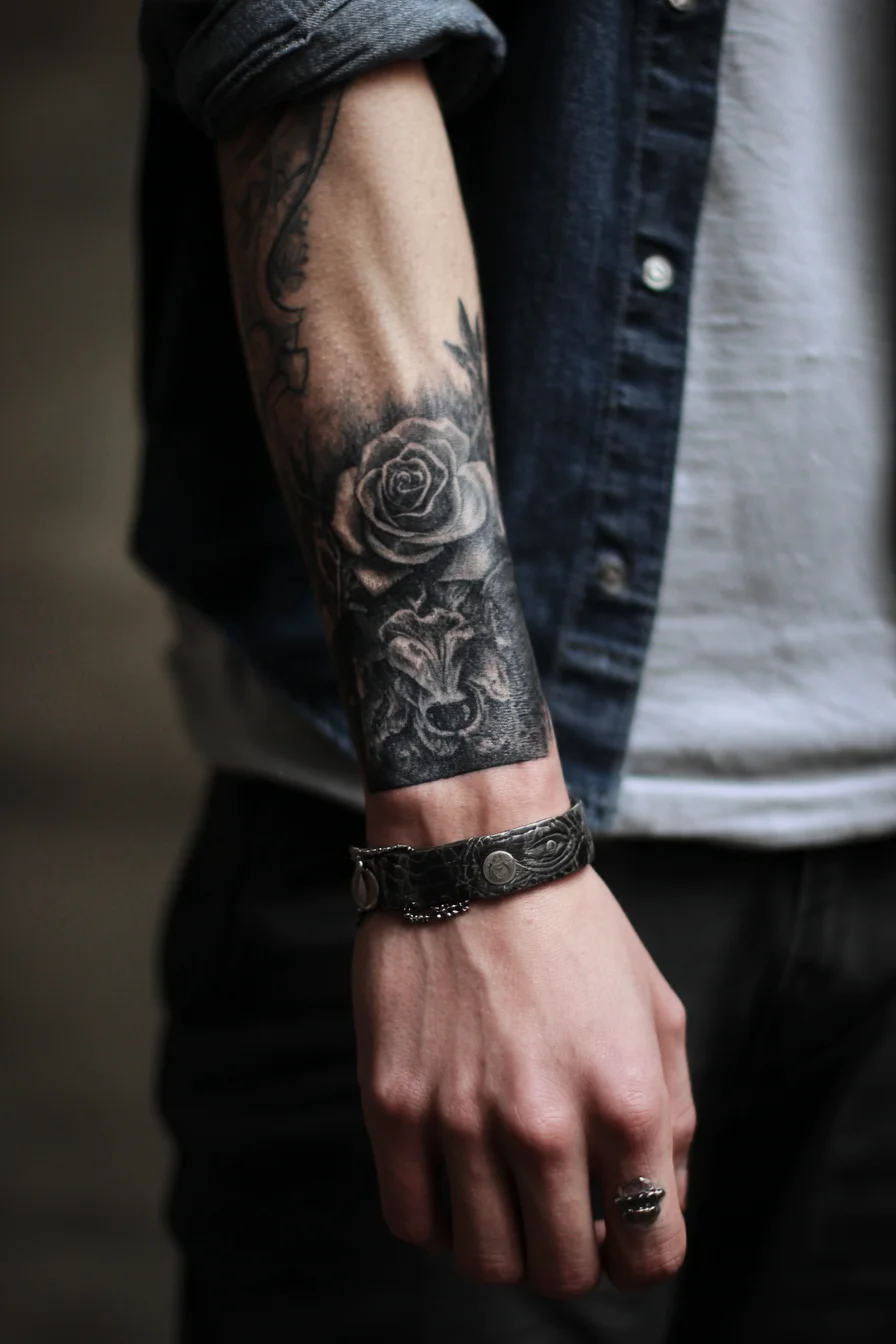
This black-and-grey forearm cuff blends a realistic rose with darker ornamental/skull elements to convey contrast: beauty and resilience, life and mortality. For men seeking a strong yet refined piece, the rose brings classic symbolism (love, memory, growth) while the darker motifs add grit and edge. Placement suggestions: outer forearm for visibility and lower pain, inner forearm for a more intimate look, or as the wrist-to-forearm start of a half- or full-sleeve. Expect low-to-moderate pain on fleshy outer forearm areas; increased sensitivity closer to the wrist, tendon lines and inner forearm will feel sharper. Size considerations: the level of shading and fine detail shown benefits from a medium-to-large canvas (4–8 inches / 10–20 cm) to preserve contrast and longevity; smaller versions should simplify elements to avoid blurring over time. Styling variations: keep it tonal for a classic masculine feel, add selective color (deep red or muted greens) for pop, shift to dotwork or geometric backgrounds for texture, or integrate script and bandwork to personalize. Discuss artist experience with realism and shading to ensure crisp, long-lasting results.
Blackwork Dragon Wrist Cuff Tattoo — Dragon, Wrist, Forearm, Cuff Design
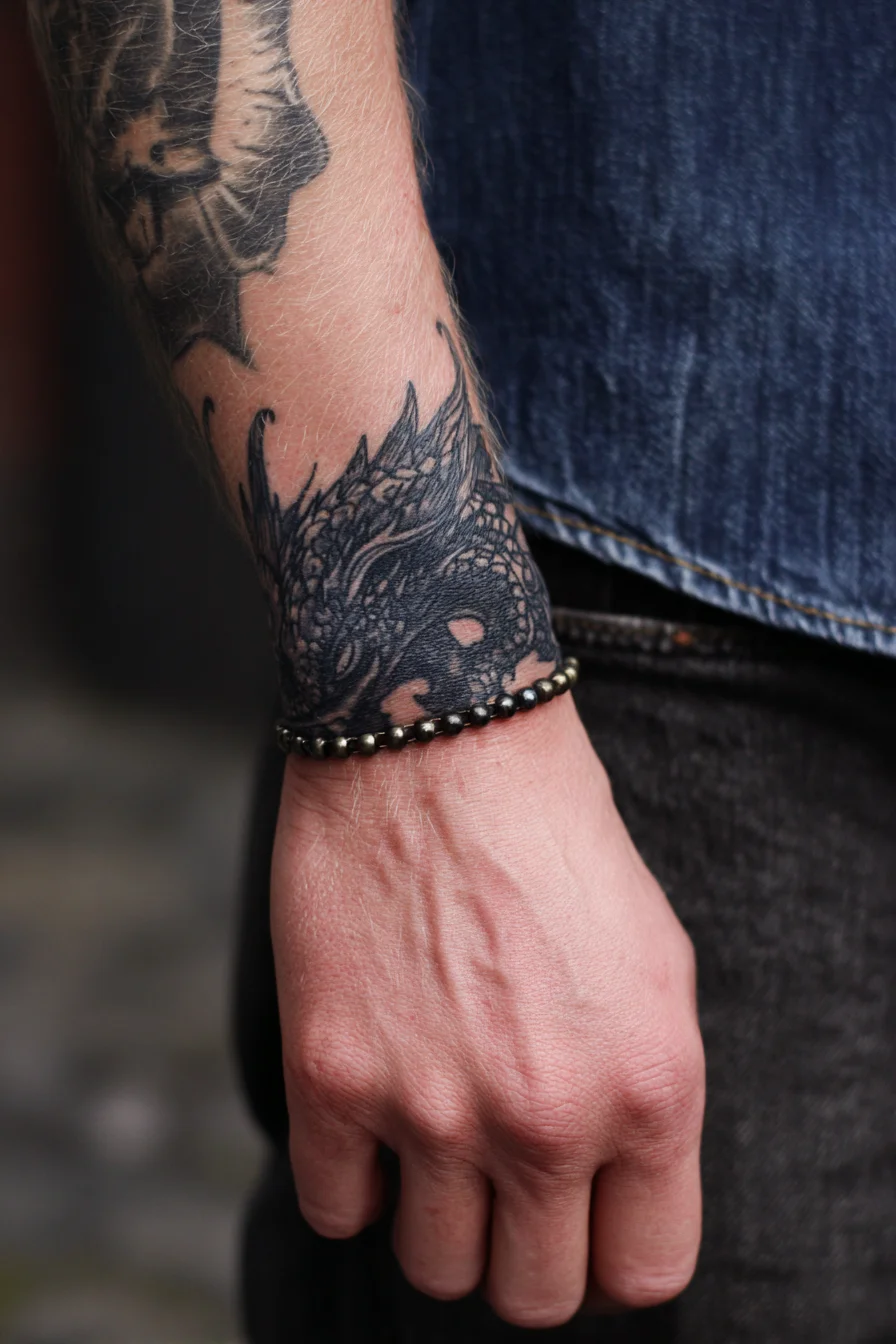
This dark, blackwork dragon cuff reads as a compact symbol of strength, protection and resilience — qualities commonly associated with dragon imagery. The dense scales and flowing mane create movement while remaining bold enough to age well. Placement suggestions: the outer wrist or lower forearm works best for a cuff-style piece that wraps slightly around the arm; extend into a half- or full-sleeve if you want continuity with existing tattoos. Pain expectations: the wrist and areas near bone (ulnar side, inner wrist) are more sensitive and can sting more than the outer forearm; expect moderate to high discomfort for tight cuff placements and lower-to-moderate pain when moving up the forearm. Size considerations: keep a wrist cuff at least 2–4 inches wide so details and shading remain crisp; expand to 6–8 inches or more for a visually balanced forearm panel. Styling variations: opt for pure blackwork for longevity, add graywash shading for depth, introduce subtle color accents (red or gold) for highlights, or pair with geometric dotwork or traditional Japanese waves for cultural fusion.
Blackwork Hand & Knuckle Tattoo — Ornamental Back‑of‑Hand and Finger Symbols
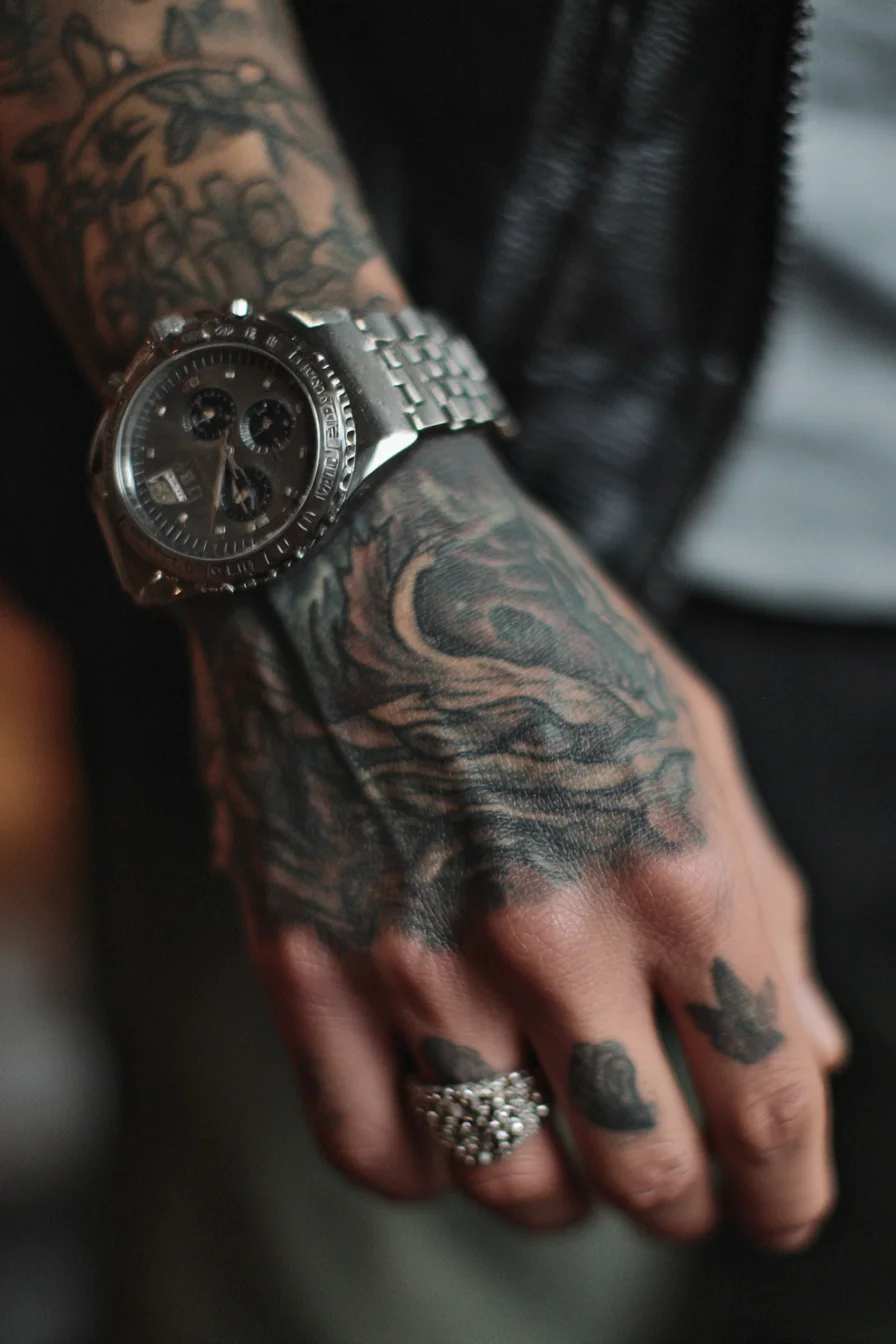
This blackwork hand design uses flowing, organic shading across the back of the hand with small, solid symbols on the knuckles and fingers. Meaning can be personal — the sweeping lines read as movement, strength or roots, while the knuckle icons act as talismans or shorthand for values. Placement: ideal for the back of the hand, knuckles and fingers; consider extending into the wrist or forearm to create a cohesive sleeve transition. Visibility is high, so factor work and social settings into your decision. Pain and healing: expect above‑average pain on knuckles and finger joints due to thin skin and bone close to the surface; the back of the hand is moderately painful. Hands are mobile and exposed, so healing can be slower and require more frequent touch‑ups. Size considerations: keep finger motifs bold and simple (6–12 mm) to avoid blur; larger hand pieces can accommodate finer shading and more detail. Styling variations include pure blackwork, dotwork textures, negative‑space highlights, adding subtle color washes, or integrating neo‑traditional elements. Work with an experienced artist who regularly tattoos hands and plans follow‑up maintenance.
Laurel Leaf Wrist Band Tattoo — Minimal Botanical Forearm Band for Men
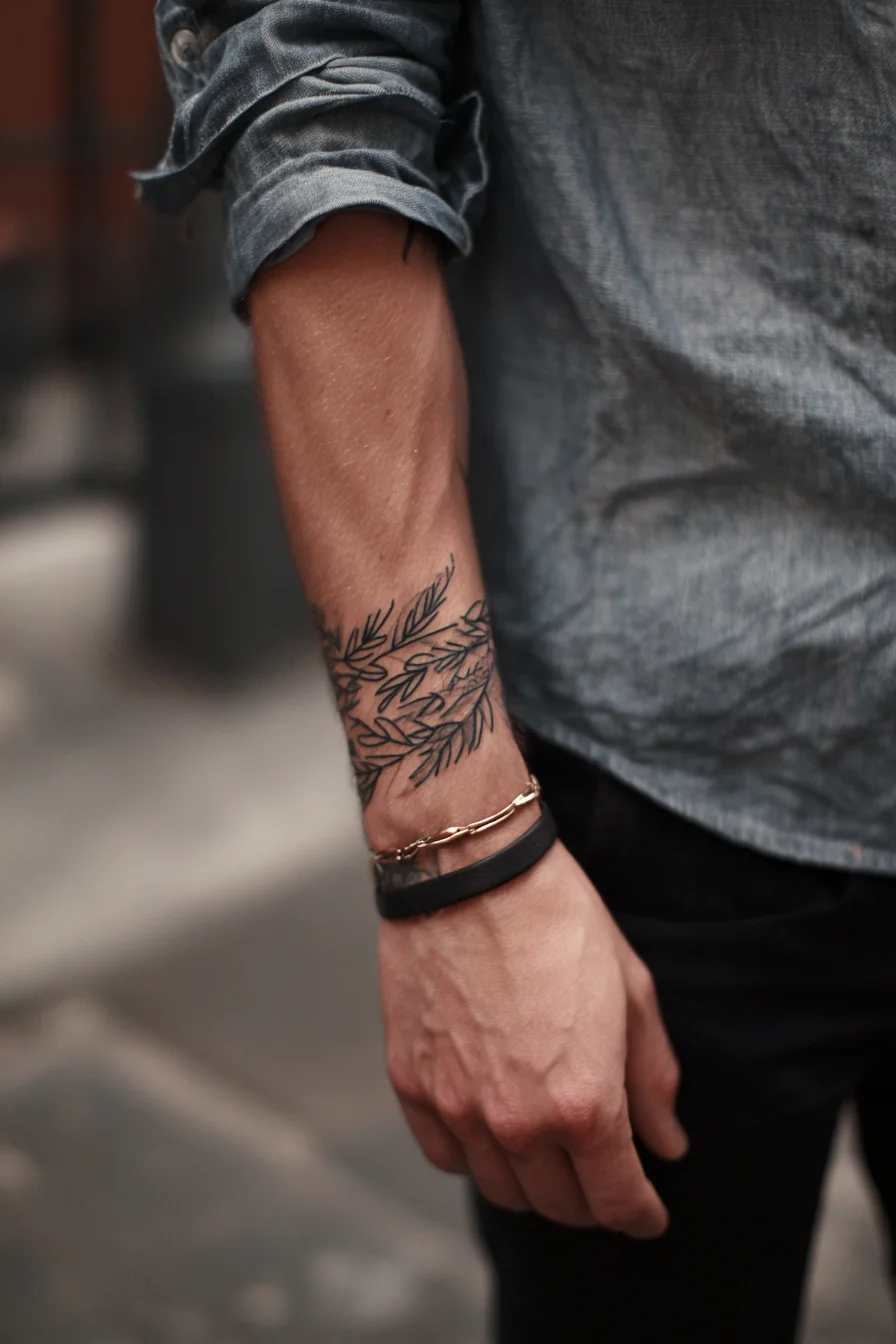
This laurel/foliage wrist band is a masculine, nature-inspired design symbolizing victory, growth and resilience. Its repeating leaf motif reads well as a wrap-around cuff or as a partial forearm piece, giving subtle statement without overpowering other tattoos. Placement suggestions: outer wrist for visibility and lower pain, inner wrist for a more intimate look, or extended as a half- or full-forearm band to integrate with sleeves. Pain expectations: wrist and around bone areas are more sensitive (moderate to high discomfort); the outer forearm and fleshy inner forearm are lower on the pain scale. Size considerations: keep band height between 2–5 cm for a wrist cuff; increase leaf scale and spacing for a forearm piece to avoid blurring over time. Styling variations: fine-line blackwork for a delicate, modern feel; bolder black or dark grey shading for contrast; dotwork or subtle green accents for texture; interrupted or layered bands to give a rugged, personalized look. Practical tip: bring reference photos to your artist, request a full wrap-around stencil to check fit, and plan a single session for linework or a second session for shading and color. Follow standard aftercare to keep lines crisp as it heals.
Horned Skull Forearm Tattoo — Blackwork Demon Skull Sleeve Accent
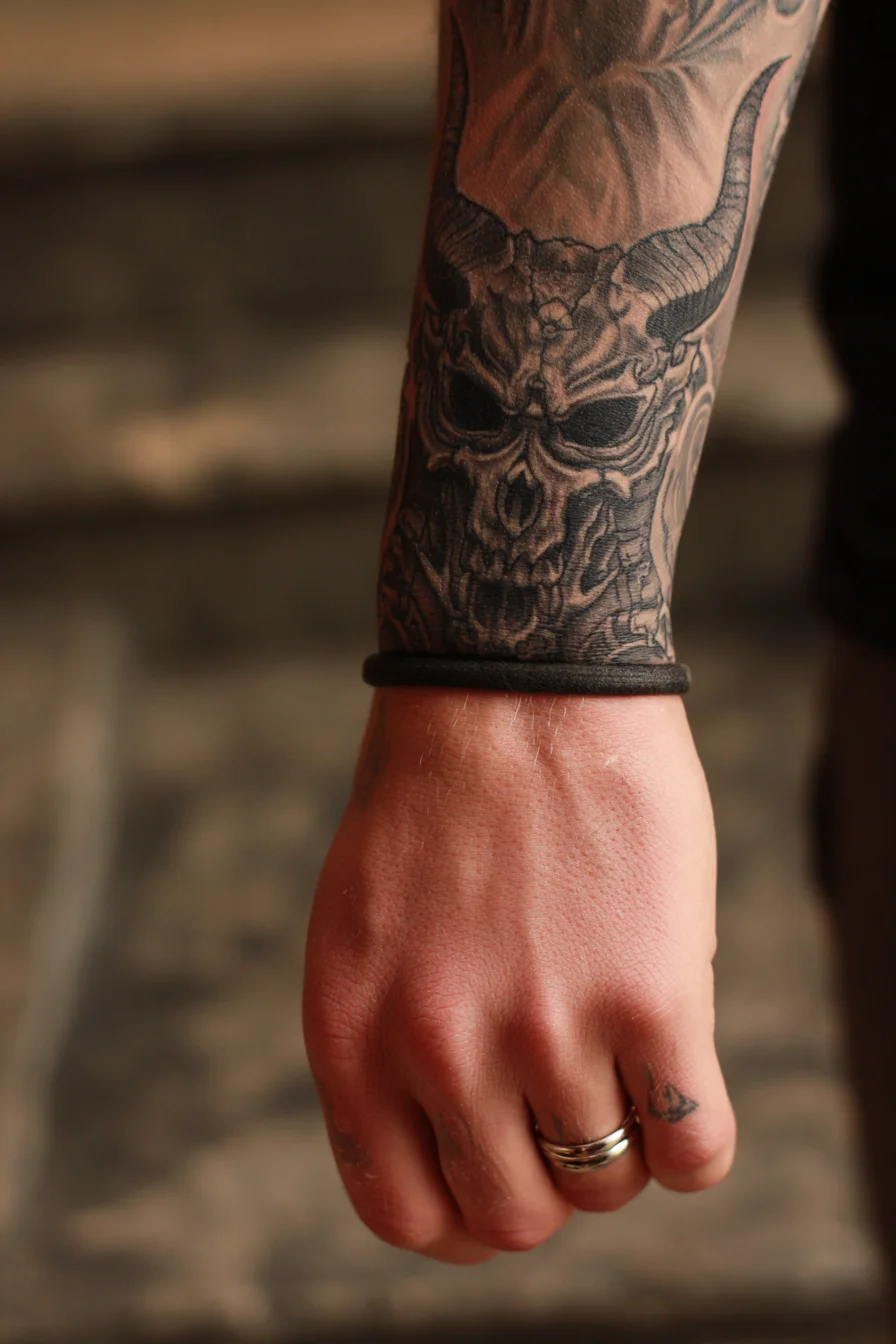
This horned skull design reads as a bold statement piece: a dark, horned skull or demon motif that symbolizes strength, mortality, defiance, and personal transformation. It works well as a standalone forearm feature or as the focal point of a half- or full-sleeve. For placement, the outer forearm offers strong visibility with lower pain and good canvas for shading; the inner forearm and wrist increase sensitivity and may require shorter sessions. Expect low-to-moderate pain on the outer forearm, higher discomfort around the wrist, hand, or bony areas, and longer sessions if integrating into a full sleeve. Size matters for detail — choose medium to large (covering 4–8 inches of forearm) to preserve the intricate horns, hollow eye-sockets, and textured shading. Styling variations include heavy blackwork/tribal, fine-line dotwork for a textured look, photorealism for lifelike depth, or neo-traditional with saturated color accents (red/orange eyes or subtle background tones). Consider negative-space highlights, smoke or geometric backgrounds, and a pre-session consultation to tailor line weight, contrast, and placement to your musculature and lifestyle.
Ornamental Black & Grey Filigree Forearm Tattoo (Masculine Sleeve Accent)
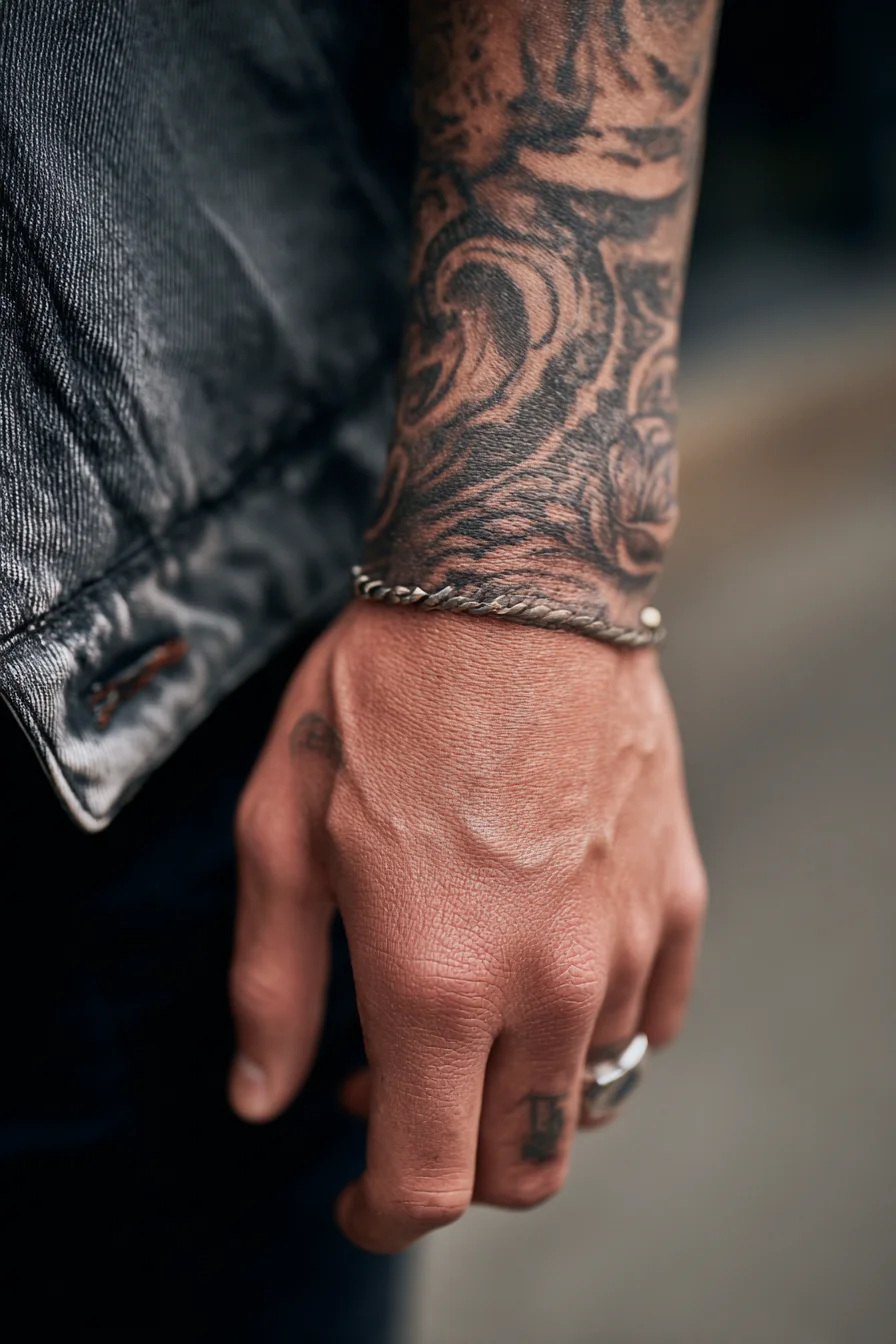
This ornamental black-and-grey filigree design reads as a modern, masculine sleeve accent that conveys movement, continuity and refined strength. Filigree and wave-like shading can symbolize heritage, resilience and a steady flow through life’s changes while keeping a distinctly low-key, sophisticated look. Placement suggestions: ideal for the outer forearm as a visible statement, the wrap-around forearm sleeve that integrates wrist-to-elbow, or scaled down into a cuff-style wrist piece; it also pairs well when extended toward the bicep or chest for a half- or full-sleeve. Pain expectations: forearm tattoos are generally low to moderate in discomfort—outer forearm is among the easier spots, while the wrist and inner forearm feel more sensitive and may sting more. Size & detail: fine filigree and smooth gradients require larger surface area to preserve detail over time; small versions should simplify linework and use bolder contrast. Styling variations: black-and-grey realism or dotwork, heavier neo-traditional outlines for longevity, or subtle color highlights/white ink accents. Consult an experienced black-and-grey artist to map flow, continuity and aftercare for best long-term results.
Black Peony Wrist Tattoo – Floral Wristband Design for Men
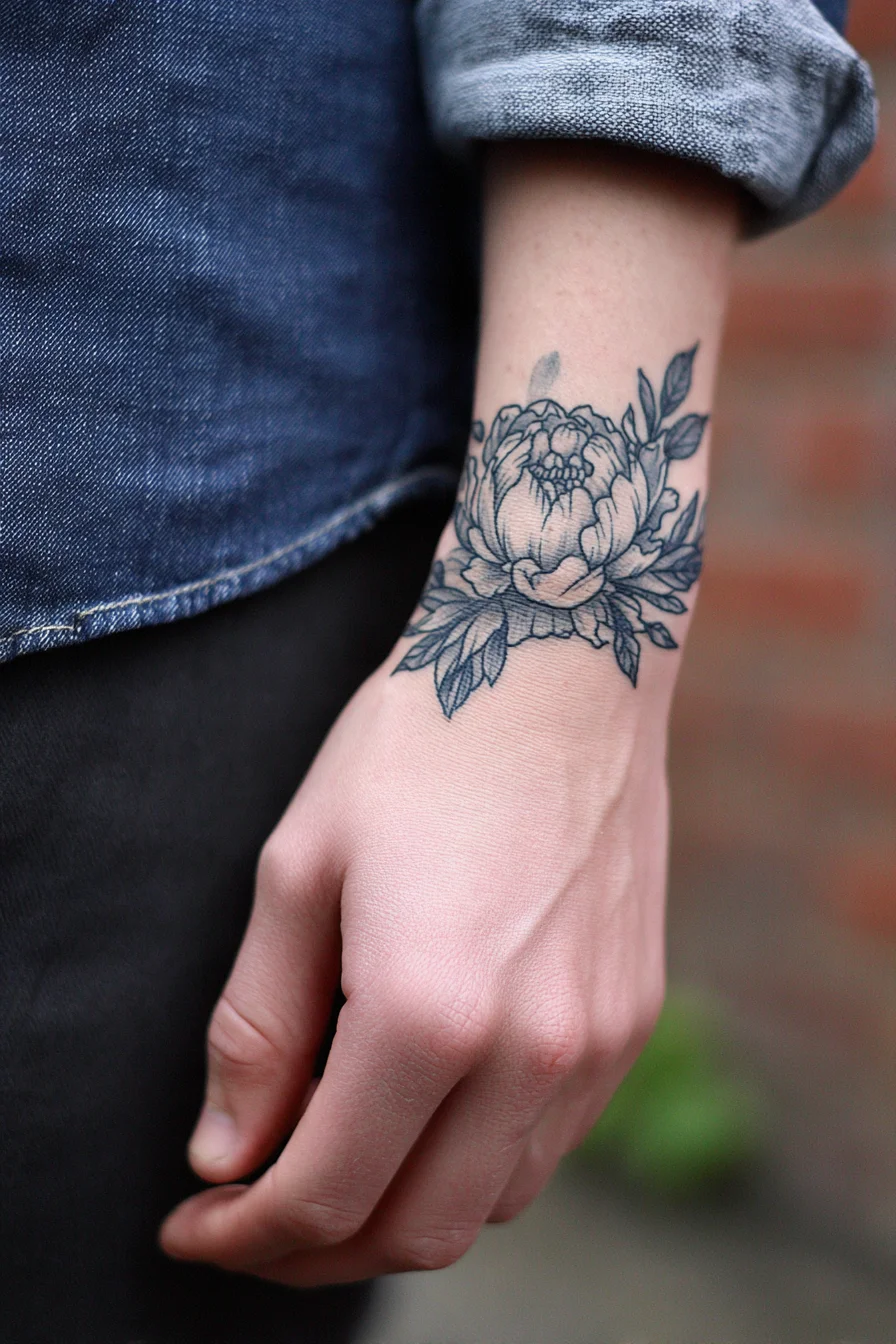
This black-ink peony wrist tattoo reads as a refined, masculine floral cuff that balances detail with clean linework. The peony traditionally represents honor, bravery and personal growth, making it a strong choice for men who want a symbolic yet elegant piece. Placement suggestions: the inner or outer wrist works well for visibility; expand the design into the forearm or wrap it around the wrist to create a cuff effect; it also translates cleanly to the upper forearm, bicep or chest. Pain expectations: the wrist is more sensitive than the fleshy forearm — expect moderate to higher discomfort near bone and tendon areas, with forearm placements being noticeably easier. Size considerations: keep wrist-only designs compact (3–6 cm) to fit anatomy; scale up to a medium piece (6–12 cm) if you plan to extend across the forearm or connect to other tattoos. Styling variations: solid black linework and fine shading for a classic look, heavier bold lines for traditional/neo-traditional aesthetics, subtle dotwork or greywash for realism, or selective color accents (deep reds or muted greens) to increase contrast and depth.
Vintage Watch Wrist Tattoo — Realism with Ink‑Splatter Accents
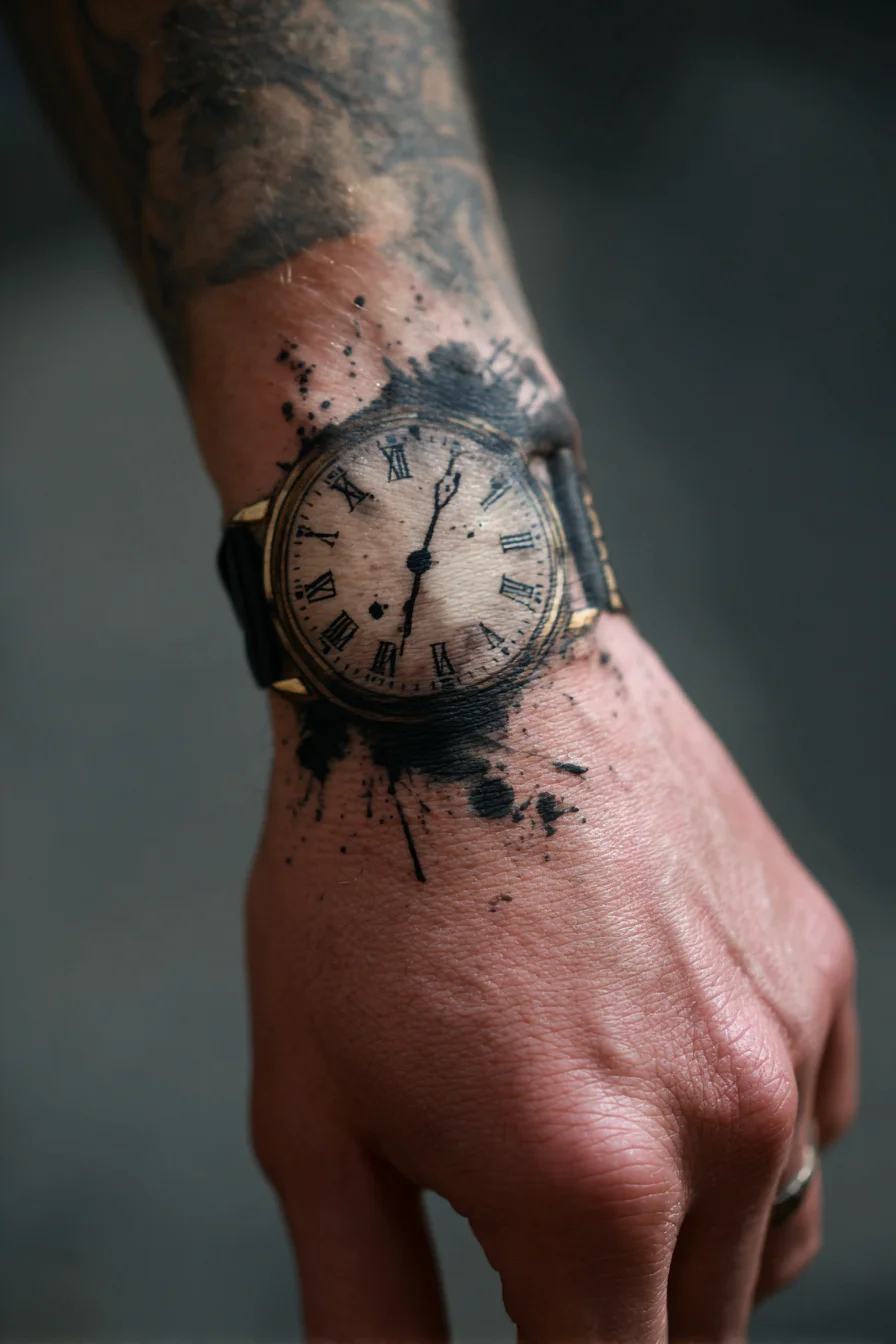
This design centers on a vintage watch face with Roman numerals and ink‑splatter accents, symbolizing time, memory, mortality, and important moments. It reads well as a personal reminder or a tribute piece and pairs strongly with masculine aesthetics when rendered in realistic black and grey with metallic highlights. Placement suggestions: wrist or top of the hand for the wristwatch illusion; inner forearm or outer forearm if you want lower pain and easier concealment; chest or upper arm to integrate into a sleeve. Pain level expectations: the wrist and hand are above-average in discomfort due to thin skin and bone proximity; inner forearm and upper arm are milder. Size considerations: to keep numerals and hands legible, aim for at least 2–3 inches (5–8 cm) across; smaller sizes risk losing fine detail and will blur sooner. Styling variations: full realism with gold/brass highlights, blackwork with heavy negative space, watercolor or splatter elements for a contemporary edge, dotwork backgrounds, or incorporation into a larger sleeve. Note: hand/wrist tattoos fade faster and commonly require touch-ups.
Blackwork Lightning Wrist Cuff Tattoo — Hand & Forearm Design
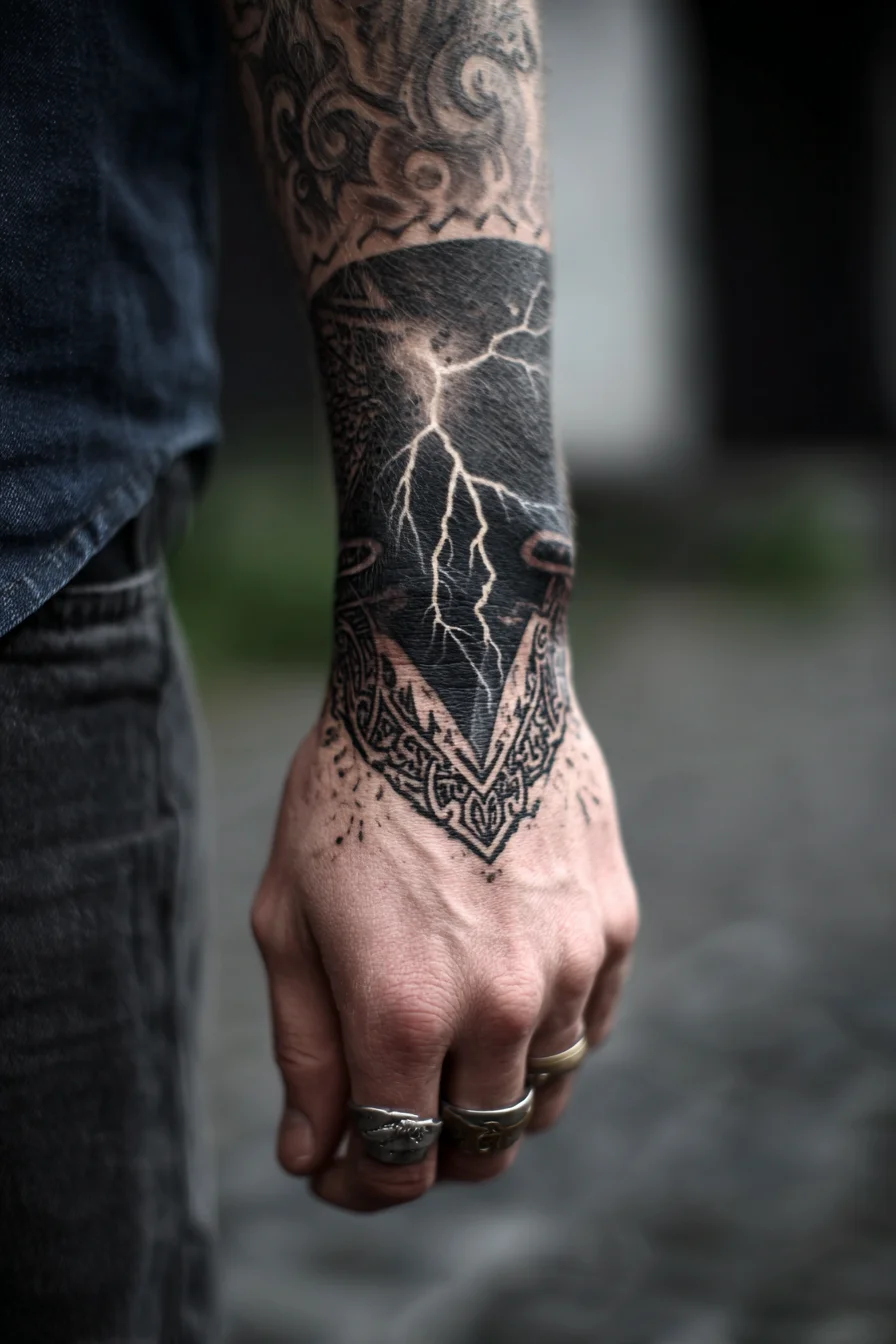
This bold blackwork cuff combines saturated negative-space lightning with intricate knotwork and a V-shaped focal point; it reads as power, resilience, and controlled chaos — a strong masculine statement that pairs well with geometric or Norse-inspired symbolism. Placement works best as a wrist-to-hand cuff or extended into a half-sleeve on the forearm. Expect higher visibility and faster fade on the dorsal hand and fingers; the forearm and inner wrist hold ink longer and allow larger compositions. Pain expectations: dorsal hand and over tendons/bone rate high (6–9/10), inner forearm and fleshy wrist areas are milder (3–6/10). Plan for precise shading sessions; large solid black areas may require multiple visits. Size considerations: a narrower cuff (3–5 cm) suits discreet wear and single-session work; a wider wrap or sleeve demands 2–3 sessions and increases healing complexity. Styling variations: convert to dotwork for texture, add white-ink highlights along lightning for contrast, introduce muted color washes (deep blue/purple) or extend into full Norse panels. Choose an experienced artist for hand pieces and budget for touch-ups and strict aftercare to maintain crisp lines.
Ornamental Mandala Cuff Wrist Tattoo — Bold Blackwork Wristband
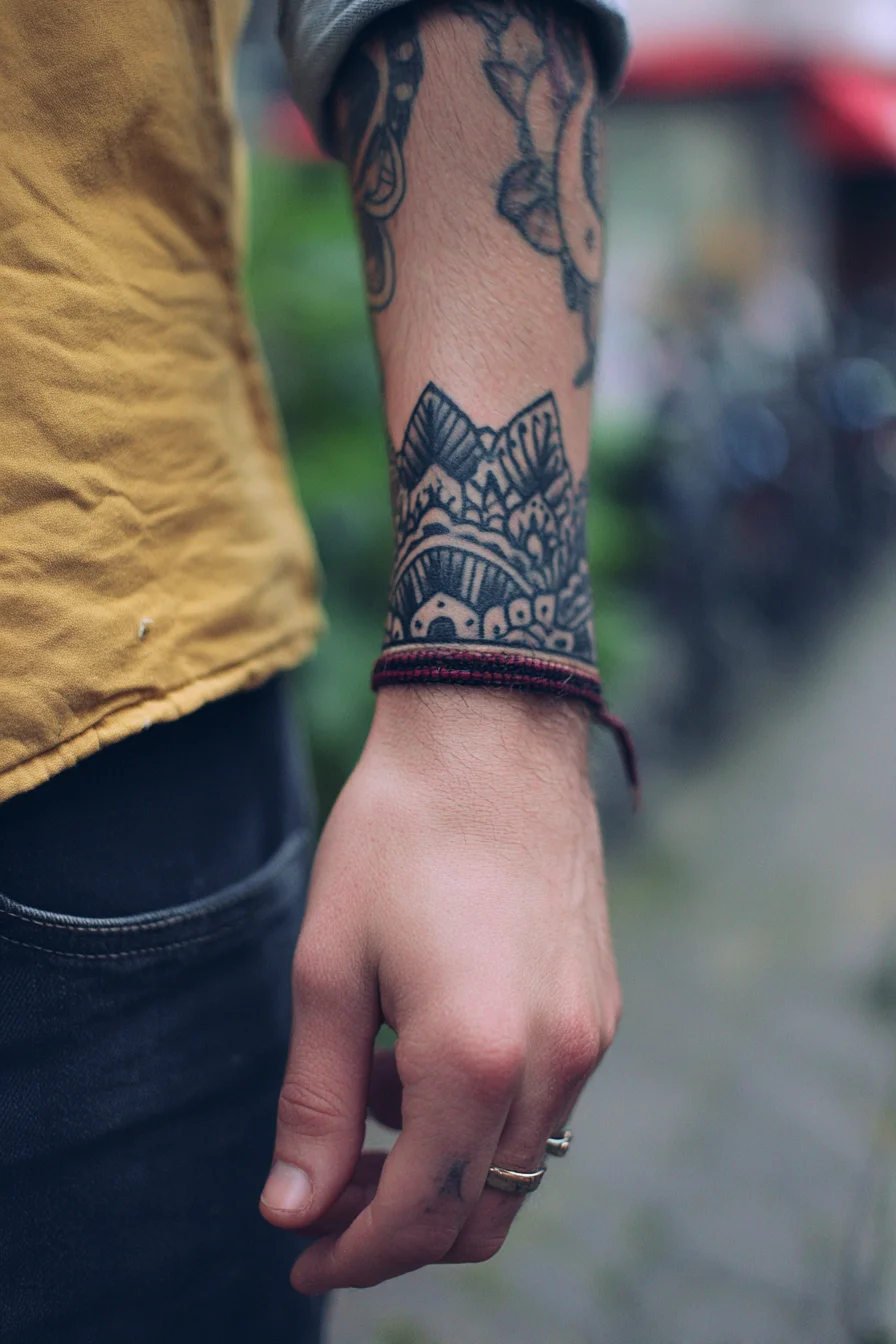
This ornamental mandala cuff reads as a modern wristband: repetitive geometry, bold outlines and intricate fills that symbolize balance, protection and personal grounding. It works well as a standalone statement around the wrist or as a transitional piece connecting to a forearm sleeve. For placement choose the outer wrist for visibility, the inner wrist for a subtler effect, or extend it onto the distal forearm to reduce wrap discomfort and allow more detail. Expect moderate to high discomfort on the wrist itself because of thin skin and proximity to bone and tendons; moving the design an inch or two up the forearm typically reduces pain. Size matters: to retain clarity, plan a cuff width of roughly 2–4 inches (5–10 cm) with line weights adjusted for longevity — very small cuffs can lose fine detail over time. Styling variations include full blackwork, dotwork shading, fine-line mandala, or adding selective color or negative-space bands for contrast. Discuss ink density and aftercare with your artist to ensure crisp lines and long-term wear, especially if you wear bracelets or rings regularly.
Geometric Celestial Wrist & Hand Tattoo — Blackwork Stars and Band
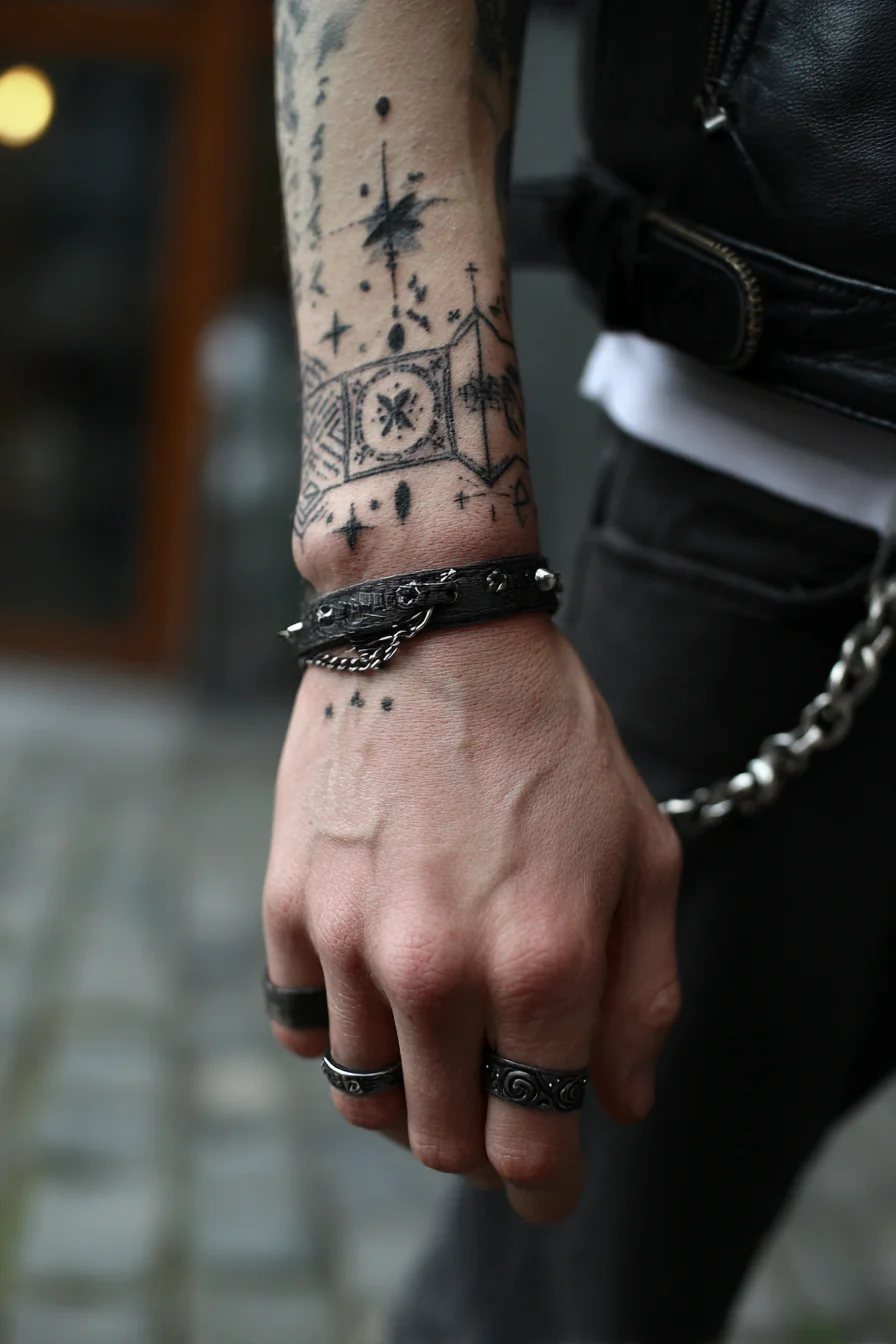
This compact geometric-celestial design reads as a modern talisman: stacked cubes, starbursts and dotwork suggest navigation, personal direction and quiet resilience. For men who want a meaningful accent rather than a full sleeve, it functions as a subtle signifier of travel, purpose or inner code. Placement suggestions: best on the outer or inner wrist as a cuff, wrapping the distal forearm, or extended onto the dorsal hand between tendons. Expect pain level to vary — wrist and hand areas are more sensitive (thin skin, bone and many nerves) so anticipate moderate to high discomfort; moving the motif onto the forearm reduces pain significantly. Size considerations: small (2–4 cm) keeps the motif crisp but will require dense, precise linework; larger cuff pieces permit more detail and negative-space patterns for longevity. Styling variations: clean blackwork and fine-line dotwork, bolder tribal-style black fills, subtle gray shading for depth, or restrained color highlights (navy/oxblood) to avoid rapid fading. Advise a tattooist experienced with hand/wrist work, plan for touch-ups, and follow strict aftercare to reduce fading from friction and sun exposure.
Blackwork Geometric Chevron Wristband Tattoo — Masculine Arrow Bracelet
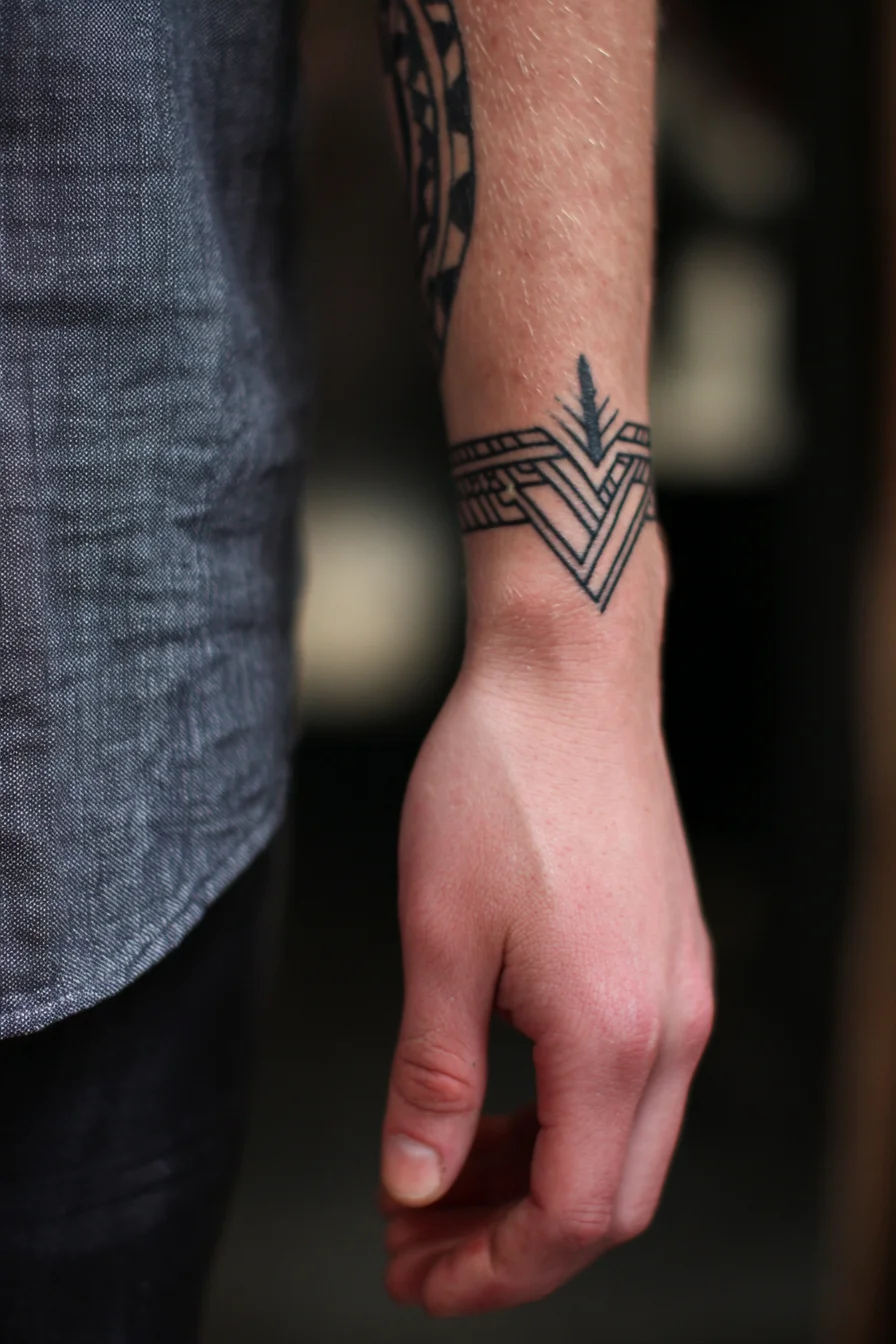
This blackwork geometric chevron wristband is a strong, minimalist design that reads as direction, protection and disciplined style. The layered V-shapes and tiny arrow detail suggest forward motion and resilience, making it a good choice for men who want a bold but understated statement. Placement: the outer or inner wrist works well for visibility; consider wrapping the band slightly onto the forearm for a more integrated look or keep it tight around the wrist as a bracelet. Pain expectations: wrists are moderately sensitive — outer wrist and over muscular forearm flesh are less painful than the inner wrist and bony areas. Expect short, manageable sessions for a single band; inner-wrist work can sting more and sometimes needs breaks. Size and longevity: choose line thickness proportional to your wrist circumference — thicker lines age better and hold detail longer; avoid extremely fine detailing on small bands. Styling variations: scale into a half-sleeve, add dotwork or subtle shading, introduce negative-space chevrons, or incorporate color accents and personal symbols. Discuss touch-ups and wear patterns with your artist during consultation.
Feather & Leaf Wristband Tattoo — Blackwork Nature Band for Men
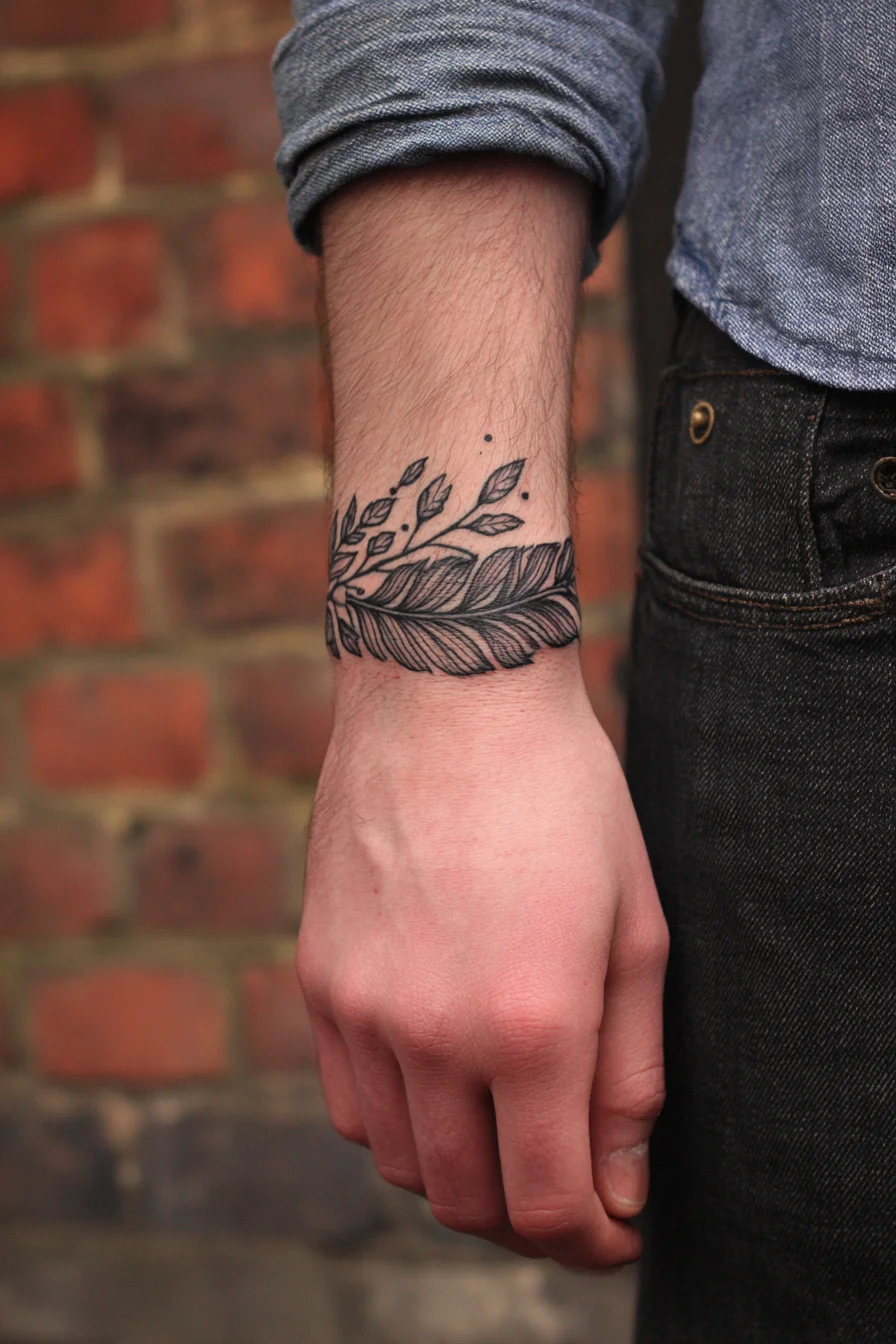
This wristband-style design combines a detailed feather with small leafy sprigs to symbolize freedom, growth and grounded resilience — a subtle nature piece that reads well for men who prefer understated symbolism. Placement works best as a low outer wrist band or wrapping slightly around the wrist like a bracelet; the outer wrist is less sensitive than the inner side, though any wrist tattoo will have moments of sharp vibration where the skin is thin over bone. Expect a moderate pain level overall, with short, concentrated discomfort during linework and shading. Size considerations: keep the band 1–2 inches tall for clarity and to maintain line integrity, or scale up slightly if you want it to wrap fully around the wrist. Ask your artist to adapt line weight and spacing for small-scale detail to avoid future blurring. Styling variations include bold blackwork for a masculine graphic look, fine-line or dotwork for a softer aesthetic, subtle green or brown highlights for a natural feel, or an extended forearm motif if you want a sleeve-compatible piece. Discuss aftercare and touch-up plans with your artist to preserve fine details.
Ornamental Tribal Wristband Tattoo – Scrollwork Armband for Men
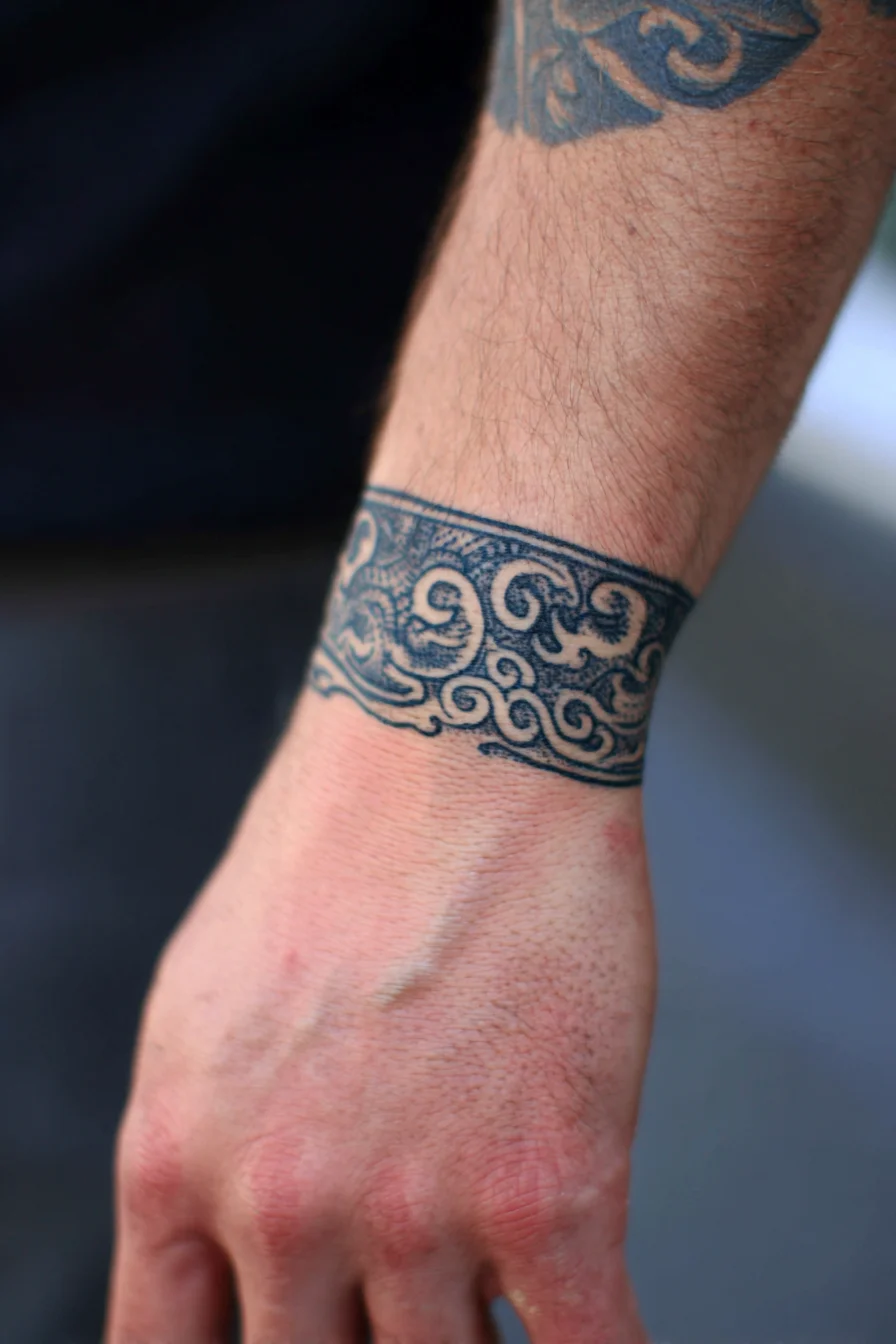
This ornamental wristband tattoo combines scrollwork and wave-like motifs to create a bracelet-style armband that reads both timeless and masculine. The repeating pattern suggests continuity, resilience, and personal boundaries — a versatile choice for marking commitments or cultural inspiration without overt symbolism. Placement suggestions: the distal forearm/wrist offers high visibility and pairs naturally with watches and bracelets; for lower pain or larger detail, scale the design to the upper forearm or bicep. Pain expectations: expect moderate to high discomfort on the wrist because of thin skin and proximity to bone and tendons; outer forearm and bicep placements are noticeably less painful. Size considerations: choose a band width proportionate to your wrist — roughly 1–2 inches wide typically balances detail and longevity on the wrist — and verify circumference measurements so the pattern wraps cleanly without distorting over veins or joints. Styling variations: solid black linework, dotwork shading, negative-space highlights, or subtle color accents (deep blue or red) all work well; consider integrating Polynesian geometry, lettering, or a sleeve transition. Consult your artist about line weight, aging of fine detail, and aftercare for crisp long-term results.
Ornamental Mandala Wrist & Hand Tattoo – Geometric Blackwork
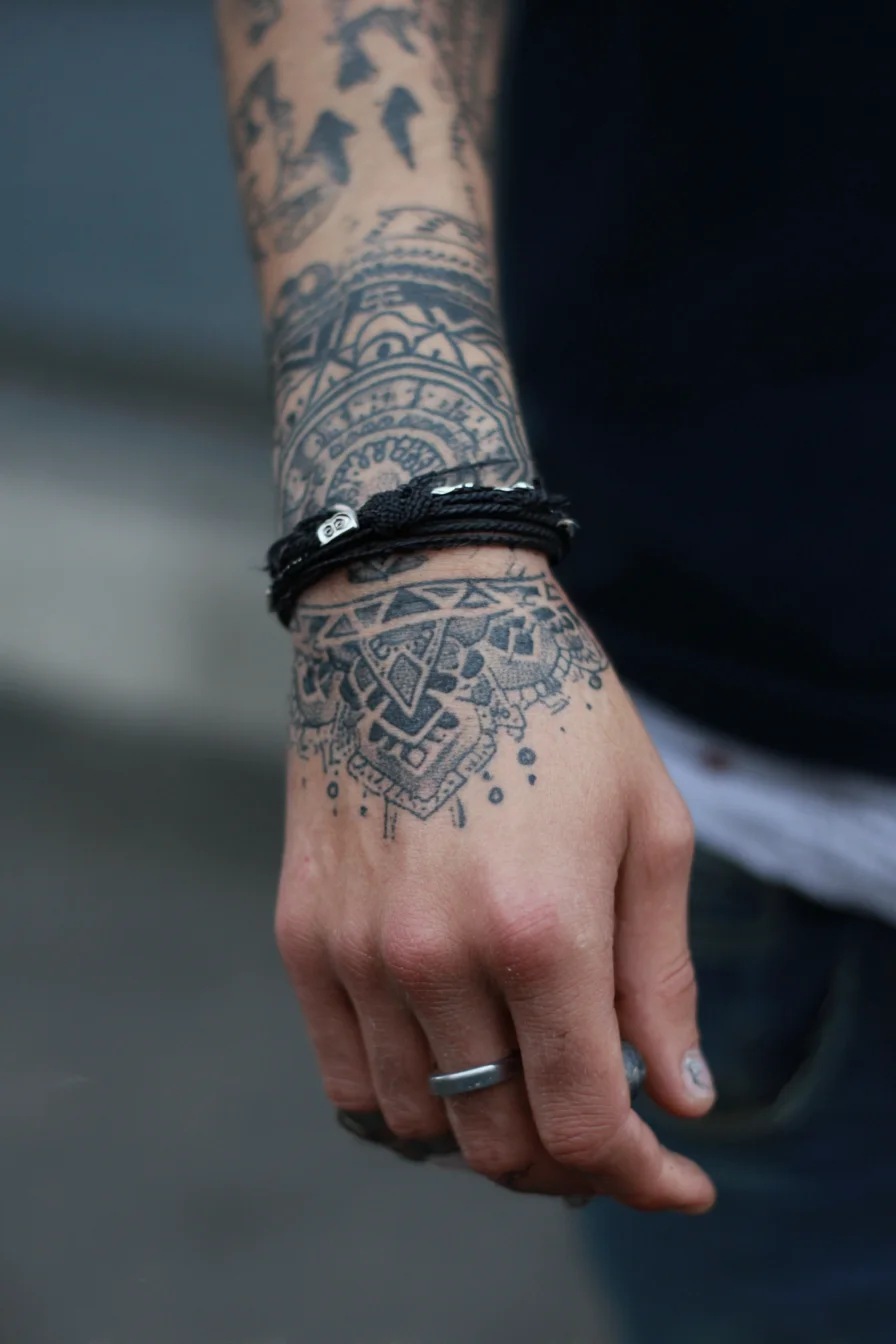
Ornamental mandala hand and wrist tattoos blend symmetry and geometry to symbolize balance, personal focus, and protection. This blackwork dot-and-line piece reads masculine on the back of the hand and wrist while still allowing subtle integration into a forearm sleeve. For placement, the back of the hand and just above the wrist are ideal if you want visible, statement work; extend pieces up the forearm for continuity or tuck the design onto the inner wrist for a more discreet option. Expect moderate to high pain on the hand and wrist because of thin skin and proximity to bone—fingers and knuckles are especially sensitive. Healing requires extra care: frequent movement, washing and sun exposure can fade fine detail. Size matters: crisp mandala detail ages better at a slightly larger scale—aim for at least 2–3 inches (5–8 cm) across for hand work; larger pieces on the forearm allow more intricate dotwork. Styling variations that suit men include bold blackwork outlines for longevity, dense dot-shading for texture, tribal or geometric extensions, or subtle color accents (deep navy or muted green). Discuss line weight and placement with your artist to ensure the design holds up over time.
Blackwork Floral Wrist & Forearm Tattoo — Linework Flower Band
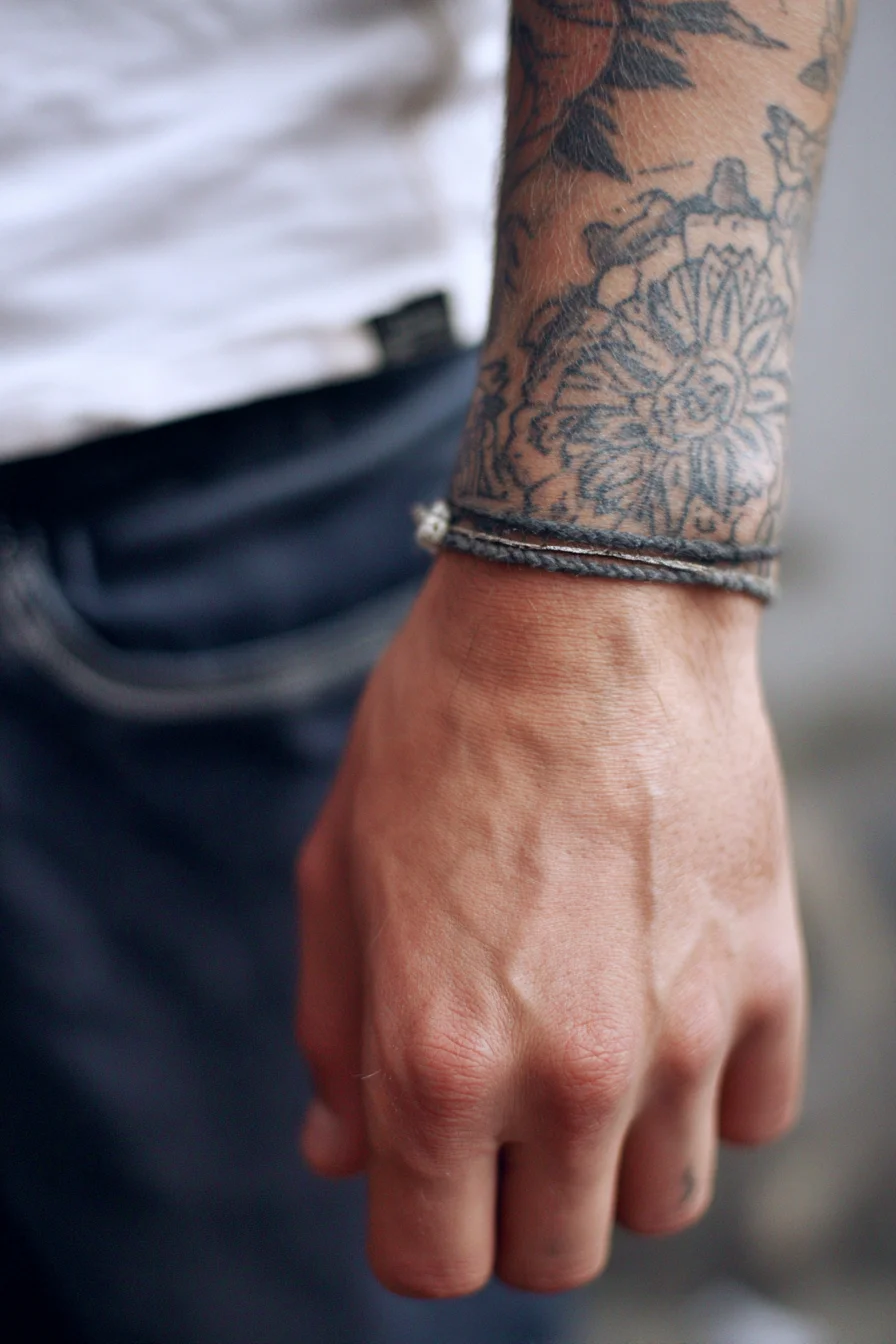
This blackwork floral band blends bold linework and delicate petal detail to symbolize growth, resilience and personal roots — themes many men choose to represent through body art. Ideal placement is around the wrist or continuing up the forearm as a cuff or partial sleeve; a wrist band is highly visible and suits casual or rugged aesthetics, while an extended forearm piece lets the artist add depth and shading. Expect varied pain: the wrist and bony areas near the hand are more sensitive, while the outer forearm is among the least painful spots. Size matters for detail — a small wrist band reads best as simplified petals and heavy outlines, while a 4–8 inch forearm piece allows for intricate shading, dotwork and negative-space highlights. Styling options include heavier blackwork for a masculine, high-contrast look; grayscale shading or stippling for texture; geometric framing for a modern edge; or selective color accents for focal points. Plan for touch-ups over time, protect from sun exposure, and consult an artist to scale the design to muscle contours and existing tattoos.
Black-and-Grey Skull Hand Tattoo — Masculine Hand & Wrist Tattoo Idea
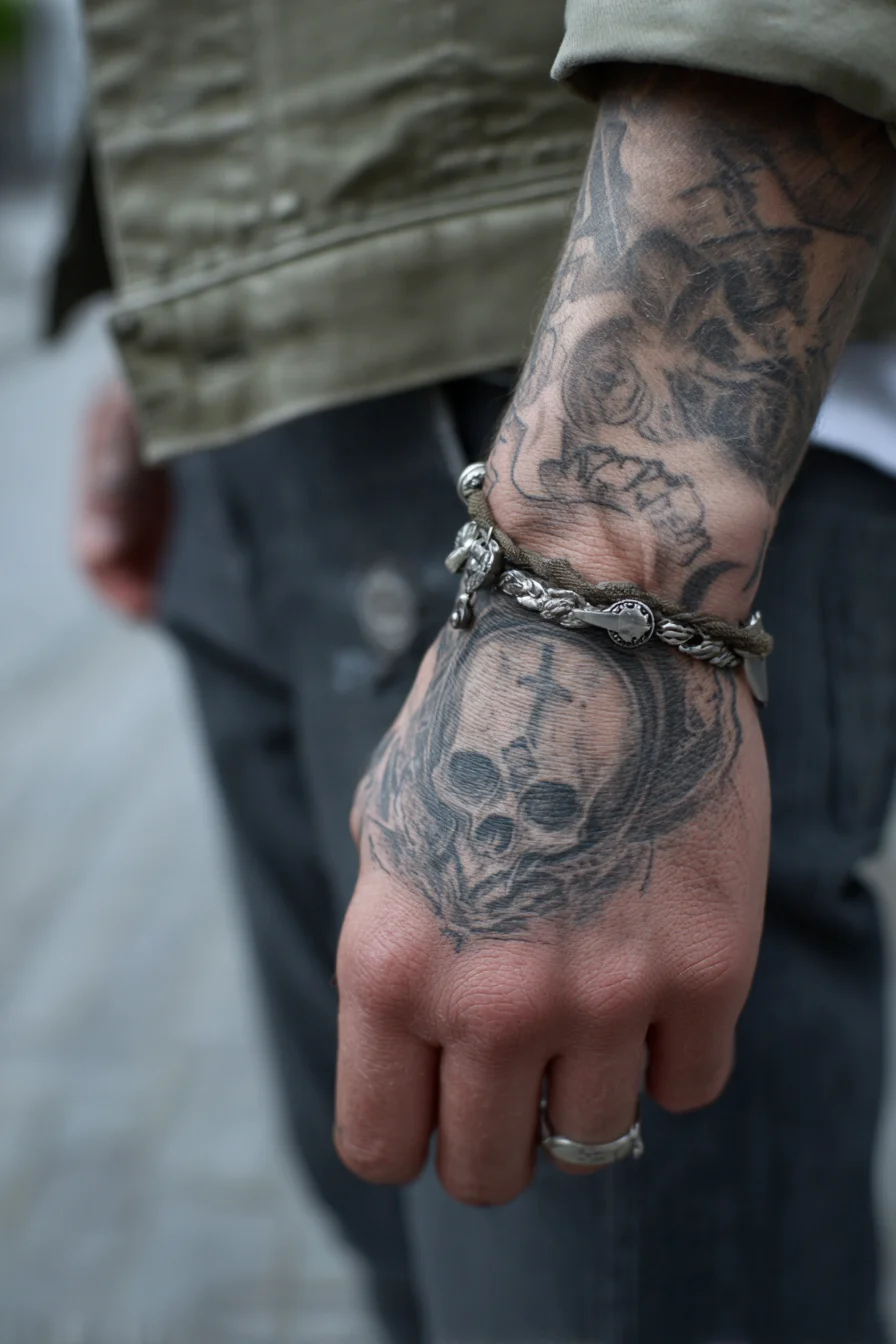
This black-and-grey skull hand tattoo reads as a bold statement piece that blends memento mori symbolism with streetwise style. Skulls traditionally represent mortality, resilience, and protection; on the hand they become a public, uncompromising declaration of identity. Placement suggestions: the dorsum of the hand and upper knuckles are shown here — ideal for visibility and for connecting into a wrist or forearm sleeve. Expect higher pain than forearm work: the hand has thin skin, less muscle and a lot of bone, so anticipate sharp, localized discomfort and shorter tattoo sessions when compared to fleshier areas. Size considerations: keep this design small-to-medium (palm-to-wrist scale) to retain detail and minimize distortion; very small skulls can lose clarity, while larger pieces allow more realistic shading. Styling variations: adapt to blackwork realism, neo-traditional bold lines, fine-line minimal skull, or dotwork/ornamental backgrounds to soften edges. Ask for a portfolio of healed hand work, plan touch-ups (hands fade faster), and follow diligent aftercare and sun protection to maximize longevity.
Mandala Wristband Tattoo — Ornamental Dotwork Wrist & Hand Design
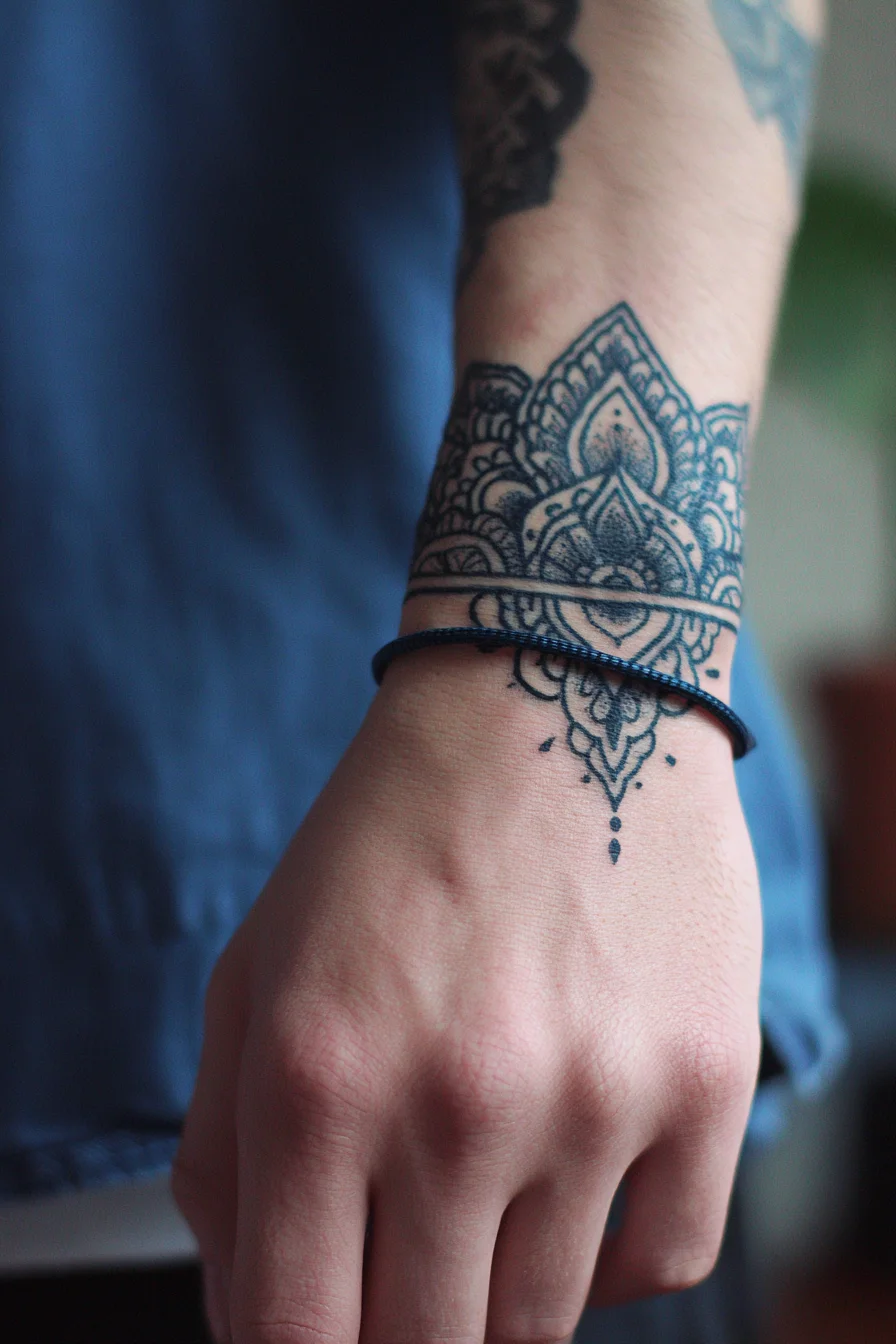
This mandala-inspired wristband blends ornamental lacework and dotwork detailing to symbolize balance, protection, and personal focus. The repeating geometric motifs read like a modern talisman — subtle enough for everyday wear yet detailed enough to stand on their own. For placement, the top of the wrist and the area just above the hand are classic choices; the piece also adapts well as a wrap-around forearm band or an accent that connects to an existing sleeve. Expect moderate pain: the bony top of the wrist and near the hand can be more sensitive than fleshier forearm areas, typically described around a 4–6/10 depending on your tolerance. Size matters for longevity and clarity — keep the main pattern at least 2–3 cm wide with clear spacing so fine lines and dotwork don’t blur over time. Styling variations include fine-line blackwork, heavier bold outlines for a rougher look, concentrated dot-shading for texture, or small color accents for contrast. Discuss line thickness and placement with your artist to ensure the design ages well and complements existing tattoos or workplace visibility preferences.
Mandala Wrist Cuff — Ornamental Blackwork Forearm Tattoo
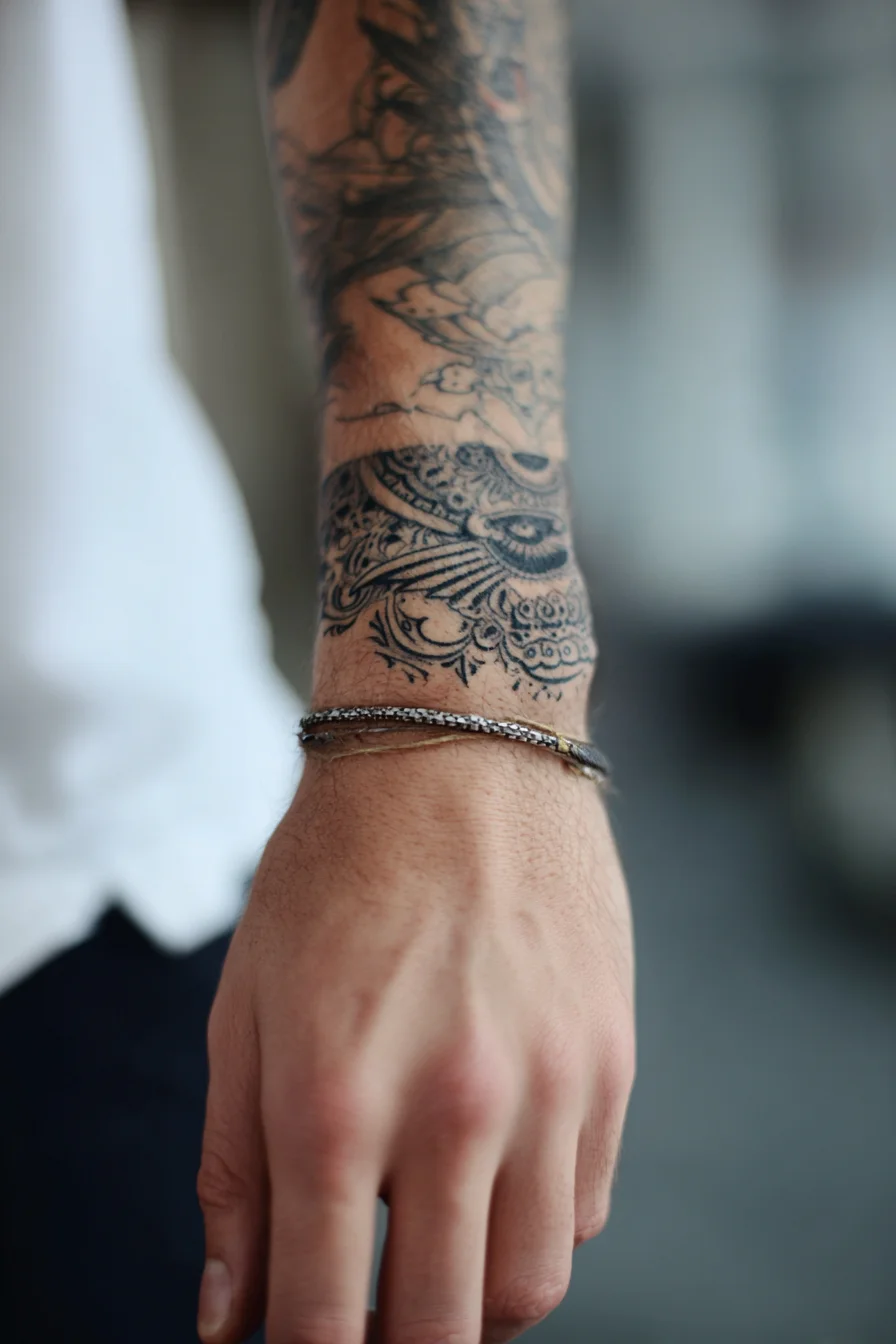
Classic mandala cuff rendered in fine-line blackwork, this ornamental wrist/forearm piece symbolizes balance, protection and focused intent. The circular, repeating patterns read well as a cuff because they contour the wrist and can be easily expanded into a half- or full-sleeve. Placement: ideal on the outer wrist and distal forearm where musculature provides canvas and visibility; consider the inner wrist for a more intimate placement. Pain: expect low-to-moderate discomfort on fleshy outer forearm and higher sensitivity over the wrist bone, tendon runs, and inner wrist. Sessions are short for small cuffs but plan for touch-ups for crisp linework. Size: widths from 1–3 inches work best; smaller cuffs demand finer needles and an experienced artist to keep lines sharp. For men wanting bolder presence, increase scale to wrap further up the forearm. Styling: options include pure blackwork or dotwork shading, thicker tribal-inspired outlines, white-ink highlights, or color accents in deep blue or red. For longevity, choose solid black for strongest fading resistance, and follow standard aftercare to protect healing lines.
Ornamental Blackwork Filigree Wrist Armband Tattoo
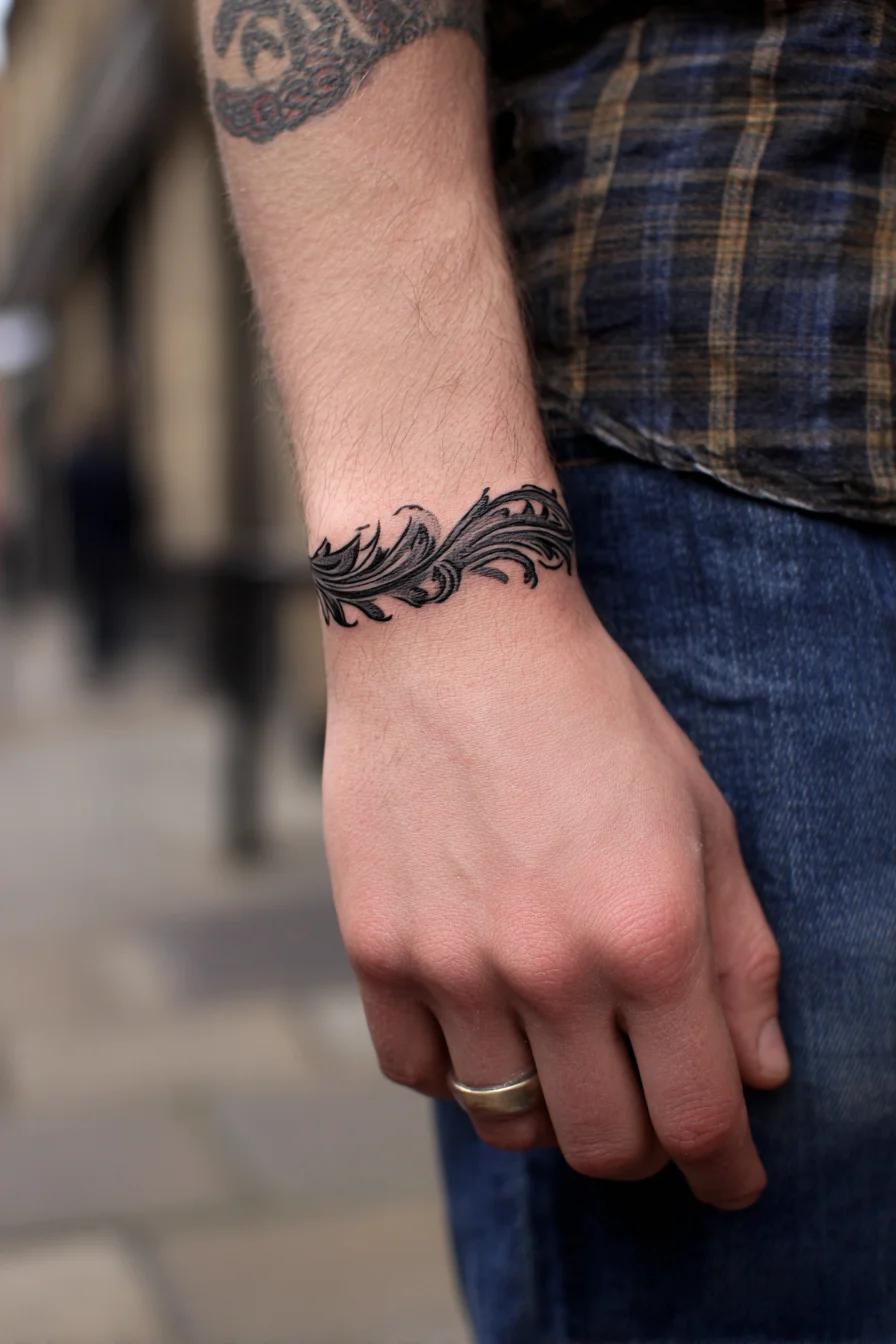
This ornamental blackwork filigree armband wraps the wrist with flowing, leaf-like flourishes for a refined yet masculine look. Symbolically it reads as continuity, personal boundary, and timeless craftsmanship—an understated way to convey strength and attention to detail without overt imagery. Placement suggestions: wear it as a visible outer-wrist band for everyday presence, move it to the inner wrist for a more private statement, or extend the motif into a forearm wrap or partial sleeve to increase scale and impact. Pain expectations: the wrist area is thin-skinned and close to bone and tendons, so expect moderate discomfort — roughly a 4–7/10 depending on exact placement; outer-wrist spots are usually less painful than areas directly over bone. Size considerations: a 1–2.5 cm band height suits most men; increase length and negative-space detailing if you plan a full wrap or integration into a sleeve. Styling variations: solid blackwork for bold contrast, greywash shading or dotwork for texture, subtle color accents (deep navy or burgundy) for personality, or a thicker tribal reinterpretation for more durability. Ask an experienced artist about line weight and aftercare — wrist pieces often need occasional touch-ups due to sun exposure and friction.
Tribal Wristband Tattoo — Polynesian Bracelet Band for Men
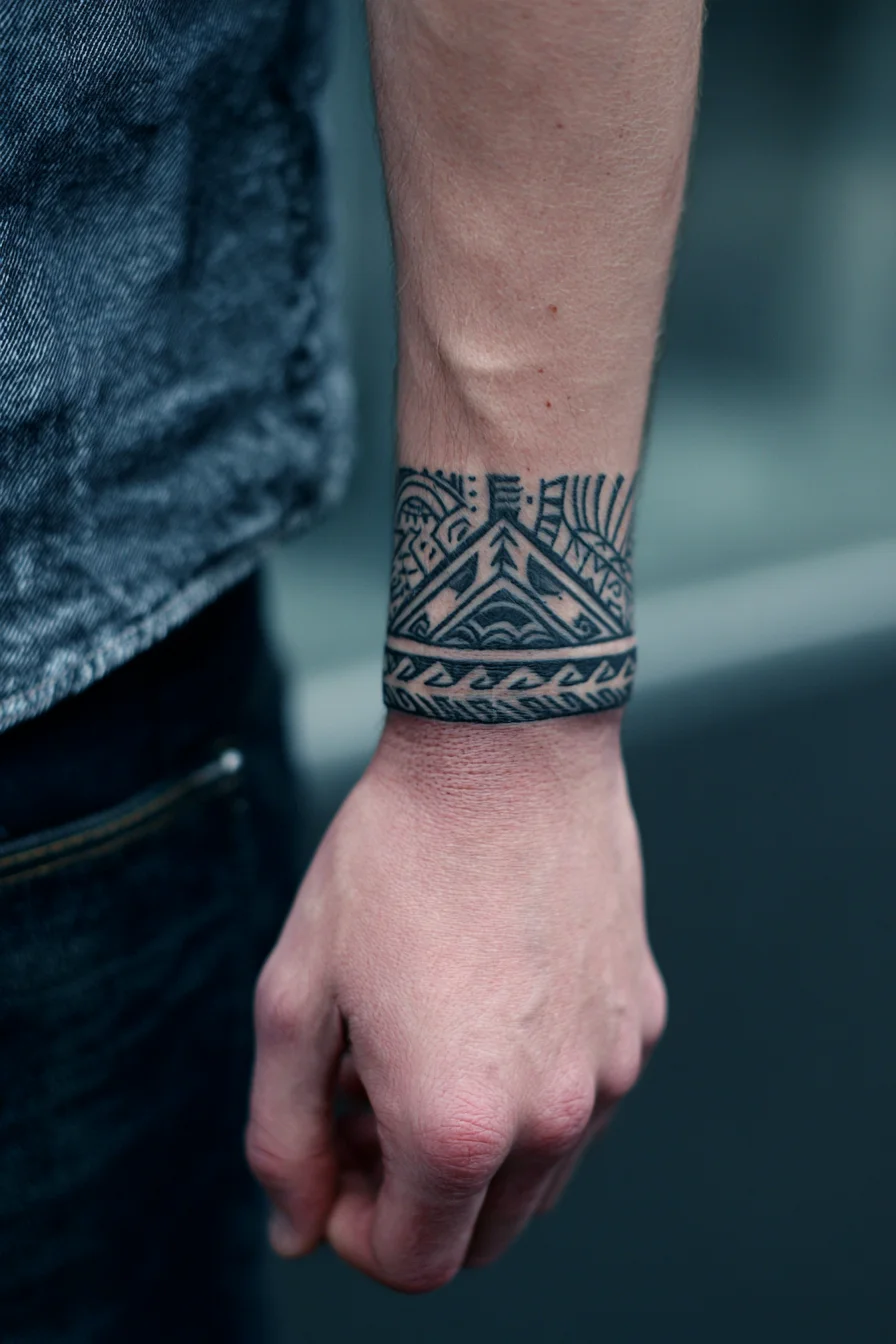
This wristband-style tattoo draws from Polynesian and geometric motifs, forming a masculine bracelet that reads bold at a glance. As a symbolic band it can represent personal boundaries, heritage, strength and continuity depending on chosen motifs. Placement works best around the outer wrist as a visible cuff, or on the inner wrist for more discreet wear; it can wrap fully around the wrist or extend into a forearm sleeve. Expect moderate to higher pain—thin skin and close bone mean sharp, intense sensations especially where the bone is exposed; on a 1–10 scale most men report 4–7 for wrist work. Size considerations: narrow bands (2–4 cm) suit subtle looks, while wider cuffs (4–6 cm) allow detailed iconography and better readable negative space. Styling variations include solid black tribal, clean fine-line geometry, dotwork shading, or subtle color accents; negative space gives contrast without heavy ink. Practical notes: discuss symmetry with your artist, consider visibility at work, and plan touch-ups—bands can blur over time. Follow standard aftercare to protect lines and prevent premature fading.
Wrist tattoos are a versatile option for men who want high-impact, personal ink in a compact area. From my experience, the keys to a successful wrist piece are appropriate scale, a clear concept, and an artist skilled in fine-line or micro work. Expect higher visibility and faster wear — so plan placement to minimize constant friction and protect the area from sun exposure during healing. Discuss pain management and realistic longevity with your artist, request a stencil or temporary first, and budget for at least one touch-up within the first year. If you have a profession with strict visibility rules, consider inner wrist placement or a discreet design. Use the 28 images here as a starting point, but always prioritize custom adjustments that fit your wrist anatomy and lifestyle. If you want help narrowing choices or preparing a reference, reach out — Hakan, Tattoo Consultant.
